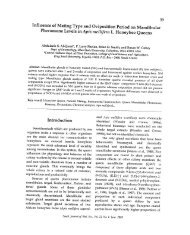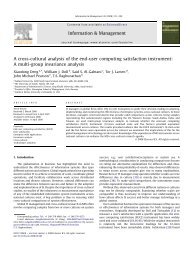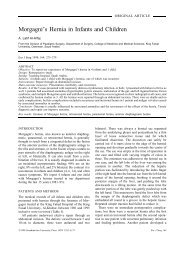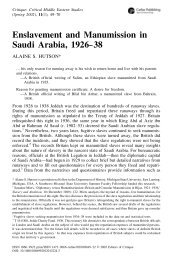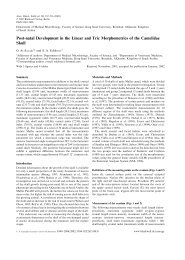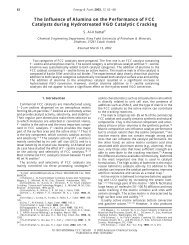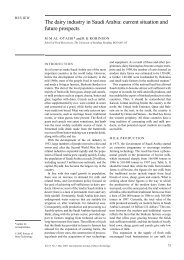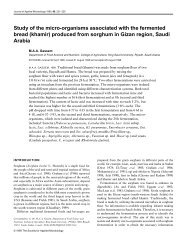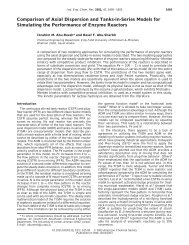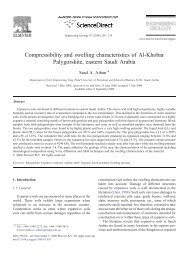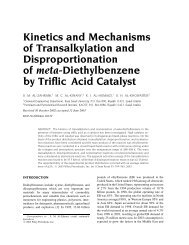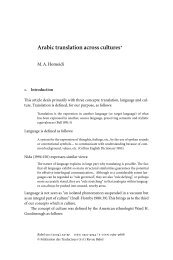Role of racemization in optically active drugs development
Role of racemization in optically active drugs development
Role of racemization in optically active drugs development
You also want an ePaper? Increase the reach of your titles
YUMPU automatically turns print PDFs into web optimized ePapers that Google loves.
Review Article<br />
<strong>Role</strong> <strong>of</strong> Racemization <strong>in</strong> Optically Active Drugs Development<br />
IMRAN ALI, 1 VINOD K. GUPTA, 2 HASSAN Y. ABOUL-ENEIN, 3 * PRASHANT SINGH, 4 AND BHAVTOSH SHARMA 4<br />
1 Department <strong>of</strong> Chemistry, Faculty <strong>of</strong> Natural Sciences, Jamia Millia Islamia (University), Jamia Nagar, New Delhi, India<br />
2 Department <strong>of</strong> Chemistry, Indian Institute <strong>of</strong> Technology, Roorkee, India<br />
3 Department <strong>of</strong> Medic<strong>in</strong>al Chemistry, College <strong>of</strong> Pharmacy, University <strong>of</strong> Sharjah, Sharjah, United Arab Emirates<br />
4 Department <strong>of</strong> Chemistry, D.A.V. (P.G.) College, Dehradun, India<br />
ABSTRACT U.S. Food and Drug Adm<strong>in</strong>istration issues certa<strong>in</strong> guidel<strong>in</strong>es for market<strong>in</strong>g<br />
<strong>of</strong> <strong>optically</strong> <strong>active</strong> <strong>drugs</strong> as some enantiomers racemize <strong>in</strong>to human body, lead<strong>in</strong>g<br />
to the generation <strong>of</strong> other antipodes, which may be toxic or ballast to the human be<strong>in</strong>gs.<br />
Moreover, <strong>racemization</strong> reduces the adm<strong>in</strong>istrated dosage concentration as <strong>optically</strong><br />
<strong>active</strong> enantiomer converted <strong>in</strong>to its <strong>in</strong><strong>active</strong> counter part. Therefore, the study <strong>of</strong> <strong>racemization</strong><br />
<strong>of</strong> such type <strong>of</strong> <strong>drugs</strong> is an important and urgent need <strong>of</strong> today. This article<br />
describes <strong>in</strong> vitro and <strong>in</strong> vivo <strong>racemization</strong> <strong>of</strong> <strong>optically</strong> <strong>active</strong> <strong>drugs</strong>. The <strong>racemization</strong><br />
process <strong>of</strong> various <strong>optically</strong> <strong>active</strong> <strong>drugs</strong> has been discussed consider<strong>in</strong>g the effect <strong>of</strong><br />
different variables i.e. pH, temperature, concentration <strong>of</strong> the drug, ionic concentration,<br />
etc. Attempts have also been made to discuss the mechanisms <strong>of</strong> <strong>racemization</strong>. Besides,<br />
efforts have been made to suggest the safe dosages <strong>of</strong> such type <strong>of</strong> <strong>drugs</strong> too. Chirality<br />
19:453–463, 2007. VC 2007 Wiley-Liss, Inc.<br />
KEY WORDS: enantiomer; epimerization; harmful effects; <strong>in</strong> vitro; <strong>in</strong> vivo; <strong>optically</strong><br />
<strong>active</strong> <strong>drugs</strong>; <strong>racemization</strong><br />
INTRODUCTION<br />
Nowadays, many <strong>drugs</strong> are used for the treatment <strong>of</strong> different<br />
diseases <strong>in</strong> human be<strong>in</strong>gs. In case <strong>of</strong> <strong>optically</strong> <strong>active</strong><br />
<strong>drugs</strong> frequently only one <strong>of</strong> the two enantiomers is pharmaceutically<br />
<strong>active</strong> while other may be <strong>in</strong><strong>active</strong> or toxic. 1,2<br />
Adm<strong>in</strong>istration <strong>of</strong> the racemic mixture <strong>of</strong> an <strong>optically</strong><br />
<strong>active</strong> drug <strong>in</strong>to human body creates confusion <strong>of</strong> its dose<br />
as about 50% is <strong>active</strong> while 50% <strong>in</strong><strong>active</strong>. Therefore, the<br />
use <strong>of</strong> <strong>optically</strong> <strong>active</strong> enantiomer is recommended under<br />
such conditions, especially <strong>in</strong> United State <strong>of</strong> America and<br />
<strong>in</strong> European countries. Even then it has been observed<br />
that, sometimes, <strong>optically</strong> <strong>active</strong> drug enantiomer racemizes<br />
<strong>in</strong>to its antipode, lead<strong>in</strong>g to various side effects and<br />
diseases. For example, ( )-form <strong>of</strong> thalidomide is harmful<br />
when adm<strong>in</strong>istered <strong>in</strong>to pregnant women and that is why<br />
(þ)-form is given under such situation. But, unfortunately,<br />
(þ)-form <strong>of</strong> thalidomide also racemizes <strong>in</strong>to ( )-enantiomer,<br />
which is responsible for morn<strong>in</strong>g sickness. 3 In<br />
addition to this, many <strong>optically</strong> <strong>active</strong> enantiomers <strong>of</strong> a variety<br />
<strong>of</strong> <strong>drugs</strong> racemize <strong>in</strong>to body <strong>of</strong> liv<strong>in</strong>g be<strong>in</strong>gs, result<strong>in</strong>g<br />
<strong>in</strong>to various side effects and diseases.<br />
Therefore, it is very important to study the <strong>racemization</strong><br />
<strong>of</strong> <strong>optically</strong> <strong>active</strong> <strong>drugs</strong>. It is difficult to study <strong>racemization</strong><br />
<strong>of</strong> <strong>drugs</strong> <strong>in</strong> vivo and therefore, study<strong>in</strong>g it <strong>in</strong> vitro is<br />
another means to deal with this problem. Many factors<br />
such as drug concentration, pH, temperature, ionic concentration,<br />
etc. are controll<strong>in</strong>g factors <strong>of</strong> <strong>racemization</strong> process.<br />
Therefore, to provide exact, safe and correct dose <strong>of</strong><br />
an <strong>optically</strong> <strong>active</strong> pharmaceutical, it is important to have<br />
VC 2007 Wiley-Liss, Inc.<br />
CHIRALITY 19:453–463 (2007)<br />
the knowledge <strong>of</strong> their <strong>racemization</strong>. Many workers studied<br />
the <strong>racemization</strong> <strong>of</strong> such type <strong>of</strong> <strong>drugs</strong>. In view <strong>of</strong> the<br />
importance <strong>of</strong> the <strong>racemization</strong> <strong>of</strong> <strong>optically</strong> <strong>active</strong> <strong>drugs</strong>,<br />
attempts have been made to review <strong>in</strong> vitro and <strong>in</strong> vivo <strong>racemization</strong><br />
<strong>of</strong> such <strong>drugs</strong>. A thorough search <strong>of</strong> literature<br />
was carried out through analytical and chemical abstracts<br />
along with the consultation <strong>of</strong> various refereed journals.<br />
The present article describes <strong>in</strong> vitro and <strong>in</strong> vivo <strong>racemization</strong><br />
<strong>of</strong> <strong>optically</strong> <strong>active</strong> <strong>drugs</strong> with respect to various<br />
operational variables. The various side effects due to <strong>racemization</strong><br />
have been <strong>in</strong>cluded <strong>in</strong> this article. Attempts<br />
have been made to discuss the mechanisms <strong>of</strong> <strong>racemization</strong>.<br />
Besides, attempts have been made to suggest the<br />
safe dosages <strong>of</strong> such type <strong>of</strong> <strong>drugs</strong> too.<br />
HARMFUL AND DIFFERENT THERAPEUTIC<br />
EFFECTS OF OPTICALLY ACTIVE DRUGS<br />
As discussed <strong>in</strong> the <strong>in</strong>troduction part <strong>of</strong> this article, one<br />
<strong>of</strong> the enantiomers may be toxic or <strong>in</strong><strong>active</strong> or ballast<br />
while its antipode may be useful therapeutically. This is<br />
Contract grant sponsor: Uttarakhand State Council for Science and Technology.<br />
*Correspondence to: Pr<strong>of</strong>essor Hassan Y. Aboul-Ene<strong>in</strong>, College <strong>of</strong><br />
Pharmacy, University <strong>of</strong> Sharjah, P. O. Box 27272, Sharjah, United Arab<br />
Emirates. E-mail: hyaboulene<strong>in</strong>@yahoo.com<br />
Received for publication 5 December 2006; Accepted 6 February 2007<br />
DOI: 10.1002/chir.20397<br />
Published onl<strong>in</strong>e 28 March 2007 <strong>in</strong> Wiley InterScience<br />
(www.<strong>in</strong>terscience.wiley.com).
454 ALI ET AL.<br />
TABLE 1. Harmful effects <strong>of</strong> <strong>racemization</strong> <strong>of</strong> <strong>optically</strong> <strong>active</strong> <strong>drugs</strong><br />
Optically <strong>active</strong> <strong>drugs</strong> Therapeutic group Species Harmful effects<br />
( )-Thalidomide Immunomodulatory<br />
Man Malformation <strong>of</strong> embryos<br />
& antiangiogenic<br />
<strong>in</strong> pregnant woman 2<br />
( )-Ibupr<strong>of</strong>en Antianalgesic Man In<strong>active</strong> 2<br />
D-DOPA Park<strong>in</strong>son’s disease Man In<strong>active</strong> 8<br />
L-Sucrose Sweet<strong>in</strong>g agent Man Non-metabolized 9<br />
D-Ribose sugar Sugar Man Less therapeutics 10<br />
L-Penicillam<strong>in</strong>e Antiarthritic Man Toxic 2<br />
(þ)-Warfar<strong>in</strong> Anticoagulant Man In<strong>active</strong> 2<br />
L-Peptide (V13KD) Antimicrobial Candida ablicans Tryps<strong>in</strong> proteolysis 11<br />
S-Albuterol Adrenergic Rat Partially <strong>active</strong> 12<br />
(þ)-Clausenamide Synaptic transducer Rat Low synaptic Transmission 13<br />
S-Propranolol b-Blockers Man Toxic 14<br />
R-Ketopr<strong>of</strong>en Antiallodynic Man In<strong>active</strong> 15<br />
R-( )-Vigabatr<strong>in</strong> Antiepileptic Man Highly toxic 16<br />
S-Tiapr<strong>of</strong>enic acid NASID Man In<strong>active</strong> 17<br />
N-Alkylated<br />
Antitumor & antimetastic Man In<strong>active</strong> 18<br />
dihydro-pyrid<strong>in</strong>e-( )-AC 394<br />
(þ)-Tramadol Analgesic Man Nausea & vomit<strong>in</strong>g 19<br />
R-CC-4047 Immunomodulatory Man In<strong>active</strong> 5<br />
(þ)-Thyrox<strong>in</strong>e Hormone Man In<strong>active</strong> 2<br />
S-Flurbipr<strong>of</strong>en NSAID Man In<strong>active</strong> 20<br />
( )-Ketam<strong>in</strong>e Anesthetic Rat In<strong>active</strong> 2<br />
(þ)-Methadone Analgesic Man In<strong>active</strong> 2<br />
(þ)-Morph<strong>in</strong>e Analgesic Man In<strong>active</strong> 2<br />
( )-Tetramisole Anthelm<strong>in</strong>tic Man In<strong>active</strong> 2<br />
S-2-[2,6-dioxopiperid<strong>in</strong>e-3-yl]-phthalimid<strong>in</strong>e Sedative Monkey Teratogenic 4<br />
R-Fenopr<strong>of</strong>en NSAID Rat In<strong>active</strong> 6<br />
( )-Fluoxet<strong>in</strong>e Anti-depressant Man In<strong>active</strong> 2<br />
(þ)-Verapamil Calcium channel blocker Man In<strong>active</strong> 2<br />
NASID: Non steroidal anti-<strong>in</strong>flammatory drug.<br />
very important <strong>in</strong>formation <strong>in</strong> medic<strong>in</strong>al and cl<strong>in</strong>ical sciences.<br />
And many authorities are ask<strong>in</strong>g data on the harmful<br />
effects <strong>of</strong> enantiomers. But unfortunately, much work<br />
could not be done <strong>in</strong> this direction and is under progress.<br />
A warn example is <strong>of</strong> ( )-thalidomide which is teratogenic<br />
<strong>in</strong> nature. 2,3 It is <strong>in</strong>terest<strong>in</strong>g to mention that the stereoselectivity<br />
<strong>of</strong> teratogenic properties <strong>of</strong> thalidomide (S-thalidomide<br />
as teratogenic enantiomer) had been observed only<br />
after <strong>in</strong>taperitoneal application, and this result still needs<br />
to be reconfirmed. L-Penicillam<strong>in</strong>e is more toxic than its Dform.<br />
R-( )-Vigabatr<strong>in</strong> is highly toxic <strong>in</strong> comparison to<br />
its enantiomers. S-2-[2,6-dioxopiperid<strong>in</strong>e-3-yl]-phthalimid<strong>in</strong>e<br />
(EM 12) was found to be teratogenic <strong>in</strong> nature. 4<br />
Besides, some enantiomers are <strong>in</strong><strong>active</strong> as for example<br />
Teo et al. 5 reported R-enantiomer <strong>of</strong> CC-4047 as less effective<br />
<strong>in</strong> human. Similarly, Berry and Jamali 6 reported R-( )fenopr<strong>of</strong>en<br />
as <strong>in</strong><strong>active</strong> antipode. Yoshida et al. 7 reported<br />
that S-enantiomer <strong>of</strong> KE-298 reflected tw<strong>of</strong>old greater area<br />
under curve (AUC) value (drug plasma concentration with<br />
time) than R-enantiomers after oral dosage <strong>in</strong> rats. The different<br />
therapeutic properties <strong>of</strong> some drug enantiomers<br />
are summarized <strong>in</strong> Table 1.<br />
RACEMIZATION OF OPTICALLY ACTIVE DRUGS<br />
As <strong>in</strong>dicated earlier the knowledge <strong>of</strong> <strong>racemization</strong> <strong>of</strong><br />
<strong>optically</strong> <strong>active</strong> <strong>drugs</strong> is essential to provide safe dosage to<br />
Chirality DOI 10.1002/chir<br />
human be<strong>in</strong>gs. Therefore, it is customary to study first<br />
the <strong>racemization</strong> <strong>in</strong> vitro followed by <strong>in</strong> vivo and, hence,<br />
the <strong>racemization</strong> <strong>of</strong> <strong>optically</strong> <strong>active</strong> <strong>drugs</strong> is discussed <strong>in</strong> the<br />
two sections i.e. <strong>in</strong> vitro and <strong>in</strong> vivo. Reist et al. 21 described<br />
the mean<strong>in</strong>g and importance <strong>of</strong> <strong>racemization</strong>, enantiomerization,<br />
diastereomerization, and epimerization. The authors<br />
def<strong>in</strong>ed the <strong>racemization</strong> as a macroscopic and statistical<br />
reaction <strong>of</strong> irreversible change <strong>of</strong> one enantiomer <strong>in</strong>to the<br />
racemic form. And enantiomerization is a microscopic process<br />
<strong>of</strong> reversible change <strong>of</strong> one enantiomer <strong>in</strong>to other.<br />
Wsol et al. 22 reviewed the chiral <strong>in</strong>version <strong>of</strong> <strong>drugs</strong> and discussed<br />
co<strong>in</strong>cidence and pr<strong>in</strong>ciple <strong>of</strong> this phenomenon. The<br />
authors discussed chiral <strong>in</strong>version <strong>of</strong> 2-arylpropionic acid<br />
derivatives. Effect <strong>of</strong> various parameters on the chiral <strong>in</strong>version<br />
and its mechanisms was also highlighted.<br />
In Vitro Racemization<br />
The <strong>racemization</strong> <strong>in</strong> test tube is called as <strong>in</strong> vitro <strong>racemization</strong>,<br />
which provides rough knowledge <strong>of</strong> the behavior <strong>of</strong><br />
<strong>optically</strong> pure <strong>drugs</strong>. However, some workers studied <strong>in</strong><br />
vitro <strong>racemization</strong> <strong>of</strong> <strong>optically</strong> <strong>active</strong> <strong>drugs</strong>, which is discussed<br />
here<strong>in</strong>. The study <strong>of</strong> ketorolac <strong>racemization</strong> was<br />
performed by Brandl et al. 23 <strong>in</strong> aqueous solution at 258C<br />
and 808C temperatures and reported a U type pH rate outl<strong>in</strong>e<br />
at 808C. The authors also reported a T 90 value <strong>of</strong> the<br />
drug <strong>in</strong> a solution <strong>of</strong> 1.5% (R)-ketorolac trometham<strong>in</strong>e at<br />
pH 7.4 and 258C temperature. Aso et al. 24 reported the
Fig. 1. The effect <strong>of</strong> c<strong>of</strong>actors on the <strong>in</strong>version <strong>of</strong> R-ibupr<strong>of</strong>en with rat<br />
liver homogenate. (*P ¼ 0.0002 decrease <strong>in</strong> R-ibupr<strong>of</strong>en concentration,<br />
**P ¼ 0.0008 <strong>in</strong>crease <strong>in</strong> S-ibupr<strong>of</strong>en concentration). 20<br />
effects <strong>of</strong> a-, b-, g- and dimethyl-b-cyclodextr<strong>in</strong>s (CDs) and<br />
liposomes on epimerization and <strong>racemization</strong> <strong>of</strong> chiral<br />
<strong>drugs</strong> such as etoposide, ethiazide, and carbenicill<strong>in</strong>. The<br />
rate <strong>of</strong> epimerization <strong>of</strong> carbenicill<strong>in</strong> <strong>in</strong>creases with a- and<br />
b-CDs but no effect was observed on epimerization <strong>of</strong> etoposide<br />
and ethiazide. Dimethyl-b-cyclodextr<strong>in</strong> dim<strong>in</strong>ishes<br />
the epimerization <strong>of</strong> etoposide and ethiazide but does not<br />
affect epimerization <strong>of</strong> carbenicill<strong>in</strong>. g-CD decreases and<br />
<strong>in</strong>creases the epimerization <strong>of</strong> etoposide and <strong>of</strong> carbenicll<strong>in</strong><br />
respectively. The authors <strong>in</strong>dicated that <strong>in</strong>clusion complexes<br />
are responsible for the retardation <strong>of</strong> <strong>racemization</strong><br />
as CDs prevented the attack by bases and buffers.<br />
The polymyx<strong>in</strong>s B and E have complex structures <strong>of</strong><br />
polypeptide antibiotics. Polymyx<strong>in</strong> B conta<strong>in</strong>s B 1,B 2,B 3,<br />
and B 4 components as major 25 while isoleuc<strong>in</strong>e-polymyx<strong>in</strong><br />
B 1 26 and polymyx<strong>in</strong> B5 and B 6 27 are m<strong>in</strong>or constituents.<br />
Similarly, polymyx<strong>in</strong> E 1 (colist<strong>in</strong> A) and polymyx<strong>in</strong> E 2 (colist<strong>in</strong><br />
B) are the ma<strong>in</strong> parts <strong>of</strong> polymyx<strong>in</strong> E whereas<br />
polymyx<strong>in</strong> E 3 and E 4, 25 norval<strong>in</strong>e-polymyx<strong>in</strong> E 1, val<strong>in</strong>epolymyx<strong>in</strong><br />
E2, 26 val<strong>in</strong>e-polymyx<strong>in</strong> E1, isoleuc<strong>in</strong>e-polymyx<strong>in</strong><br />
E 1 and isoleuc<strong>in</strong>e polymyx<strong>in</strong> E 2 28 are m<strong>in</strong>or identities.<br />
Orwa et al. 27 described the decomposition <strong>of</strong> polymyx<strong>in</strong><br />
with <strong>racemization</strong> as the pr<strong>in</strong>cipal mechanism <strong>of</strong> decomposition<br />
at pH 1.4 and 7.4 pH. The traits <strong>of</strong> decomposition<br />
were studied <strong>in</strong> aqueous solution at different pHs and temperatures.<br />
At constant pH and temperature it was found<br />
that the decomposition k<strong>in</strong>etics <strong>of</strong> polymyx<strong>in</strong>s follows<br />
pseudo first order k<strong>in</strong>etics.<br />
Knih<strong>in</strong>icki et al. 20 studied the <strong>racemization</strong> <strong>of</strong> R-ibupr<strong>of</strong>en<br />
<strong>in</strong> rat liver homogenate <strong>in</strong> the presence <strong>of</strong> ATP, CoA<br />
and (ATP and CoA both) and <strong>in</strong> the absence <strong>of</strong> ATP and<br />
CoA both for 30 m<strong>in</strong> at 378C separately and respectively. A<br />
remarkable change occurred <strong>in</strong> the concentration <strong>of</strong> Rand<br />
S-ibupr<strong>of</strong>en enantiomers <strong>in</strong> the presence <strong>of</strong> both ATP<br />
and CoA together (see Fig. 1). The <strong>in</strong>version <strong>of</strong> R-ibupr<strong>of</strong>en<br />
was not reported <strong>in</strong>to kidney and <strong>in</strong>test<strong>in</strong>e homogenates <strong>of</strong><br />
rat under the above cited four conditions. R-Ibupr<strong>of</strong>en was<br />
mixed with rat liver homogenates hav<strong>in</strong>g c<strong>of</strong>actors and<br />
was observed a decrease <strong>in</strong> the concentration <strong>of</strong> R-ibupro-<br />
RACEMIZATION IN OPTICALLY ACTIVE DRUGS DEVELOPMENT<br />
455<br />
fen after 10 m<strong>in</strong>. No decrease was observed <strong>in</strong> the concentration<br />
<strong>of</strong> R-ibupr<strong>of</strong>en <strong>in</strong> absence <strong>of</strong> CoA. The <strong>racemization</strong><br />
<strong>of</strong> R- and S-ibupr<strong>of</strong>en-CoA <strong>in</strong> buffer {TRIS HCl [tris-(hydroxymethyl)<br />
methylam<strong>in</strong>e hydrochloride)] 50 mM, pH<br />
7.4} and <strong>in</strong> fresh human plasma is shown <strong>in</strong> Figures 2a<br />
and 2b, which <strong>in</strong>dicates the different pattern <strong>of</strong> <strong>racemization</strong><br />
under vary<strong>in</strong>g conditions. Other authors also reported<br />
the <strong>in</strong>version <strong>of</strong> R-ibupr<strong>of</strong>en <strong>in</strong> gu<strong>in</strong>ea pigs 29 with the observation<br />
<strong>of</strong> stereospecific <strong>in</strong>version by CoA. Caldwell<br />
et al. 30 also reported the spontaneous <strong>racemization</strong> <strong>of</strong> Ribupr<strong>of</strong>en-CoA.<br />
In 1989, Knih<strong>in</strong>icki et al. 20 studied <strong>in</strong> vitro<br />
<strong>racemization</strong> <strong>of</strong> (R)-ibupr<strong>of</strong>en only. Furthermore, Knih<strong>in</strong>icki<br />
et al. 31 carried out the <strong>racemization</strong> <strong>of</strong> R- and S-enantiomers<br />
<strong>of</strong> 2-arylpropionic acids. The <strong>racemization</strong> and hydrolysis<br />
processes <strong>in</strong> vitro condition have been performed<br />
us<strong>in</strong>g rat liver homogenate and subcellular fractions. The<br />
authors reported that the rat liver homogenate showed<br />
<strong>racemization</strong> <strong>of</strong> (R)-ibupr<strong>of</strong>en-CoA to (S)-ibupr<strong>of</strong>en-CoA<br />
Fig. 2. The <strong>racemization</strong> <strong>of</strong> R- andS- ibupr<strong>of</strong>en-CoA <strong>in</strong> (a) buffer (tris<br />
HCl, 50 mM, pH 7.4) and (b) fresh human plasma. [R-Ibupr<strong>of</strong>en (*), Sibupr<strong>of</strong>en<br />
(l) after mild alkal<strong>in</strong>e hydrolysis and R-ibupr<strong>of</strong>en concentrations<br />
(D) before alkal<strong>in</strong>e hydrolysis.] 16<br />
Chirality DOI 10.1002/chir
456 ALI ET AL.<br />
Time (m<strong>in</strong>)<br />
TABLE 2. Enantiomeric ratio <strong>of</strong> Ibupr<strong>of</strong>en as<br />
CoA-thioesters and free after <strong>in</strong>cubation <strong>in</strong> liver<br />
mitochondrial fraction <strong>of</strong> rat 31<br />
(R)-Ibupr<strong>of</strong>en-CoA (S)-Ibupr<strong>of</strong>en-CoA<br />
S/R CoA S/R Free R/S CoA R/S Free<br />
10 0.76 0.61 0.77 0.67<br />
20 0.62 0.69 0.58 0.78<br />
30 0.70 0.67 0.56 0.77<br />
60 0.56 0.67 0.63 0.77<br />
with the amount <strong>of</strong> (S)-ibupr<strong>of</strong>en formed equal to lost<br />
amount <strong>of</strong> (R)-ibupr<strong>of</strong>en. In the same way, (S)-ibupr<strong>of</strong>en-<br />
CoA racemized to (R)-ibupr<strong>of</strong>en-CoA, and their rate <strong>of</strong> hydrolysis<br />
and <strong>racemization</strong> was reported same as for<br />
(R)- and (S)-ibupr<strong>of</strong>en-CoA. The mitochondrial fraction<br />
mediated the <strong>racemization</strong> and hydrolysis <strong>of</strong> (R)- and (S)ibupr<strong>of</strong>en-CoA<br />
<strong>in</strong> the same pattern as rat liver homogenate.<br />
The enantiomer ratio <strong>of</strong> ibupr<strong>of</strong>en-CoA with rat liver<br />
mitochondrial fraction was not altered even after 1 h period<br />
<strong>of</strong> experiment. Table 2 31 shows the ratios <strong>of</strong> S/R CoA<br />
as free S/R, which <strong>in</strong>dicates different pattern <strong>of</strong> <strong>racemization</strong><br />
<strong>in</strong> rat liver mitochondrial fraction. A rapid <strong>racemization</strong><br />
and hydrolysis <strong>of</strong> (R)-ibupr<strong>of</strong>en-CoA to (S)-ibupr<strong>of</strong>en-CoA<br />
was reported <strong>in</strong> microsomal fraction. (S)-Ibupr<strong>of</strong>en-CoA<br />
racemized and hydrolyzed to (R)-ibupr<strong>of</strong>en-CoA with<br />
microsomal fraction. But it was observed that the rate<br />
<strong>of</strong> hydrolysis <strong>of</strong> (S)-ibupr<strong>of</strong>en was slower than that <strong>of</strong><br />
(R)-ibupr<strong>of</strong>en-CoA. In rat liver microsomal fraction, a<br />
difference <strong>in</strong> enantiomer ratios was reported and given<br />
<strong>in</strong> Table 3. 31 Knadler and Hall 32 reported the <strong>racemization</strong><br />
and hydrolysis <strong>of</strong> CoA thioesters <strong>of</strong> (R)-ibupr<strong>of</strong>en<br />
and (R)-fenopr<strong>of</strong>en with rat liver microsomal and mitochondrial<br />
fraction, which supported the f<strong>in</strong>d<strong>in</strong>gs <strong>of</strong><br />
Nakamura et al. 33 <strong>in</strong> 1981. Skalova et al. 34 reported chiral<br />
<strong>in</strong>version <strong>of</strong> R-(þ)-flobufen and (2S;4S)-dihydr<strong>of</strong>lobufen<br />
(DHF) <strong>in</strong> human hepatocytes. The authors also<br />
reported the unidirectional chiral <strong>in</strong>version <strong>of</strong> the enantiomers<br />
<strong>of</strong> dihydr<strong>of</strong>lobufen (DHF) as (2S;4S)-DHF to<br />
(2R;4S)-DHF and from (2R;4R)-DHF to (2S;4R)-DHF <strong>in</strong><br />
hepatocyte cultures. The chiral <strong>in</strong>version has also been<br />
discussed for 2-aryloxypropionates 35,36 and for D-leuc<strong>in</strong>e<br />
37 <strong>in</strong> human hepatocytes. Wsol et al. 38 studied <strong>in</strong><br />
vitro stereoselective biotransformation <strong>of</strong> flobufen enantiomers<br />
<strong>in</strong> hepatocytes <strong>of</strong> male rat. The authors also<br />
reported that bidirectional chiral <strong>in</strong>version occurred <strong>in</strong><br />
flobufen enantiomers with hepatocytes.<br />
Yang et al. 39–47 carried out a remarkable work on the<br />
<strong>racemization</strong> <strong>of</strong> various <strong>optically</strong> <strong>active</strong> <strong>drugs</strong>. The<br />
authors 45 reported that the conjugated benzylic C-H at chiral<br />
center was responsible for the <strong>racemization</strong> reaction <strong>in</strong><br />
oxazepam. Yang and Lu 44 studied the temperature dependent<br />
<strong>racemization</strong> <strong>of</strong> 3-methoxy-N-desmethyldiazepam <strong>in</strong><br />
acetonitrile and methanol hav<strong>in</strong>g 0.5 M H 2SO 4. Yang and<br />
Bao 42 reported base catalyzed <strong>racemization</strong> <strong>of</strong> 3-O-acyloxazepam.<br />
The authors studied the k<strong>in</strong>etics <strong>of</strong> <strong>racemization</strong> <strong>in</strong><br />
alkal<strong>in</strong>e solutions with and without buffered conditions.<br />
The authors also <strong>in</strong>dicated that <strong>in</strong> aqueous solutions the<br />
Chirality DOI 10.1002/chir<br />
<strong>racemization</strong> process took place with chang<strong>in</strong>g rates at pH<br />
7.5–14. The authors also suggested that this <strong>racemization</strong><br />
reaction occurred due to keto-enol tautomerism between<br />
C 2 carbon <strong>of</strong> CO group and C 3 carbon catalyzed by a<br />
base. Similarly, Yang 43 reported acid catalyzed <strong>racemization</strong><br />
<strong>of</strong> 3-O-methyloxazepam <strong>in</strong> ethanol and 3-O-ethyl oxazepam<br />
<strong>in</strong> methanol. The authors suggested that the above<br />
cited reaction occurred via C 3 carbocation <strong>in</strong>termediate.<br />
Yang et al. 41 reported that the enantiomers <strong>of</strong> oxazepam<br />
(OX) and temazepam (TMZ) showed the <strong>racemization</strong><br />
reactions 40 times faster than <strong>of</strong> hydrolysis <strong>of</strong> these racemates.<br />
The authors added that only hydrolysis results<br />
showed <strong>racemization</strong> reaction. Furthermore, Yang 40 studied<br />
the k<strong>in</strong>etics <strong>of</strong> spontaneous <strong>racemization</strong> and stereoselective<br />
conversion <strong>of</strong> temazepam (TMZ) enantiomers to<br />
3-O-methyltemazepam (MeTMZ) and 3-O-ethyltemazepam<br />
(EtTMZ). The authors also reported that N 4-protonated<br />
and unprotonated enantiomers <strong>of</strong> (S)-TMZ showed spontaneous<br />
<strong>racemization</strong>. A highly stereoselective nature was<br />
shown by three S-OH group <strong>of</strong> (S)-TMZ giv<strong>in</strong>g EtTMZ as<br />
a substituted product, which has greater proportion <strong>of</strong> (S)-<br />
EtTMZ. Sulla 48 reported that various aliphatic acid chlorides<br />
[RCH(R’)COCl], hav<strong>in</strong>g a chiral center adjacent to<br />
carboxylic group, showed a high degree <strong>of</strong> <strong>racemization</strong><br />
with strong acids.<br />
Ferorelli et al. 49 studied <strong>racemization</strong> <strong>of</strong> <strong>optically</strong> <strong>active</strong><br />
acid chlorides <strong>of</strong> cl<strong>of</strong>ibric acid with 3-tropanol. The authors<br />
reported that methanolic KOH hydrolysis <strong>of</strong> the methyl<br />
esters <strong>of</strong> 2-(4-chlorophenylthio)propanoic acid was produced<br />
as racemic mixture. The partial <strong>racemization</strong> <strong>of</strong> the<br />
above cited drug was reported with am<strong>in</strong>oalcohols as free<br />
base for the correspond<strong>in</strong>g esters and no <strong>racemization</strong><br />
was reported with am<strong>in</strong>oalcohols as hydrochloride salts. 50<br />
Mey et al. 51 reported 23–25 m<strong>in</strong> as half life <strong>of</strong> <strong>racemization</strong><br />
for (þ)- and ( )-diethylpropion (DEP) <strong>in</strong> human plasma.<br />
Tumambac et al. 52 reported half life <strong>of</strong> 2-benzoylcylohexanone<br />
<strong>in</strong> hexanes and ethanol as 552 and 23.8 m<strong>in</strong> respectively<br />
at 668C. Fernandez et al. 53 reported <strong>in</strong>creas<strong>in</strong>g <strong>racemization</strong><br />
<strong>of</strong> zopiclone (ZOP) enantiomers with <strong>in</strong>creas<strong>in</strong>g<br />
pH and temperature. Lamparter et al. 54 studied the <strong>racemization</strong><br />
<strong>of</strong> (þ)-chlorthalidone with variation <strong>of</strong> pH and<br />
reported a m<strong>in</strong>imum pH 3 for log K/pH curve. The<br />
authors also discussed that the rate <strong>of</strong> <strong>racemization</strong><br />
decreased with <strong>in</strong>creas<strong>in</strong>g liposome concentration. Teo<br />
et al. 5 reported the <strong>racemization</strong> <strong>of</strong> S-enantiomer <strong>of</strong> CC-<br />
4047 <strong>in</strong> phosphate buffer. The authors claimed S-enan-<br />
Time (m<strong>in</strong>)<br />
TABLE 3. Enantiomeric ratio <strong>of</strong> Ibupr<strong>of</strong>en as<br />
CoA-thioesters and free after <strong>in</strong>cubation <strong>in</strong> liver<br />
microsomal fraction <strong>of</strong> rat 31<br />
(R)-Ibupr<strong>of</strong>en-CoA (S)-Ibupr<strong>of</strong>en-CoA<br />
S/R CoA S/R Free R/S CoA R/S Free<br />
2 0.19 0.18 0.10 1.30<br />
5 0.22 0.19 0.19 0.57<br />
10 0.27 0.18 0.23 0.70<br />
20 0.47 0.19 0.21 0.98<br />
30 0.56 0.21 0.13 0.95<br />
60 0.76 0.25 0.10 0.82
TABLE 4. Racemization <strong>of</strong> different <strong>drugs</strong> <strong>in</strong> phosphate<br />
buffer (0.01 m) at pH 7.4 a62<br />
Compound<br />
tiomer as more powerful than racemic mixture. Murakami<br />
et al. 55 reported the <strong>racemization</strong> <strong>of</strong> R-t-butyl-2-(3,4-O-carbonyldioxy-phenyl)-2-(phthalimidooxy)<br />
acetate <strong>in</strong> diethylketone<br />
<strong>in</strong> presence <strong>of</strong> small amount <strong>of</strong> 1,8-diazabicyclo[5.4.0]undec-<br />
7-ene. Gaitani et al. 56 studied the epimerization <strong>of</strong> thioridaz<strong>in</strong>e<br />
2-sulfoxide (THD 2-SO) <strong>in</strong> human plasma, buffer and<br />
methanolic solutions under different experimental conditions<br />
<strong>of</strong> <strong>in</strong>cubation. The authors reported that both enantiomers<br />
<strong>of</strong> THD-2-SO were stable at vary<strong>in</strong>g temperature,<br />
pH and ionic strength but at pH 8.5 solubility problems<br />
were reported. In the presence <strong>of</strong> the enantiomer <strong>of</strong> THD or<br />
racemic mixture <strong>in</strong> the <strong>in</strong>cubation mixture, the valuable differences<br />
were reported <strong>in</strong> the formation <strong>of</strong> THD metabolites<br />
<strong>in</strong> vitro stereoselective THD metabolism. 57 Knoche et al. 58<br />
reported the <strong>racemization</strong> <strong>of</strong> thalidomide <strong>in</strong> phosphate buffer<br />
<strong>of</strong> pH 7.4 at 378C temperature. 2-Phthalimid<strong>in</strong>oglutarimide<br />
and 2-phthalimidoadip<strong>in</strong>imide (derivatives <strong>of</strong> thalidomide)<br />
showed a rapid <strong>racemization</strong>. 59,60 Nunes et al. 61 described<br />
the epimerization reaction <strong>of</strong> pilocarp<strong>in</strong>e (2S:3R) at C-2<br />
chiral atom at pH 7.4 and 358C with half life <strong>of</strong> 36 days.<br />
Pepper et al. 62 reported <strong>in</strong> vitro <strong>racemization</strong> <strong>of</strong> aromatase<br />
<strong>in</strong>hibitors i.e. 3-(4-am<strong>in</strong>ophenyl)-pyrrolid<strong>in</strong>e-2,5-dione, its Npentyl<br />
analogue and antifungal econazoles (hav<strong>in</strong>g benzylic<br />
protons) at pH 7.4 <strong>in</strong> phosphate buffer. The authors<br />
described that (þ)- and ( )-3-(4-am<strong>in</strong>ophenyl)pyrrolid<strong>in</strong>e-<br />
2,5-dione (WSP-3; I), (þ)- and ( )-1-pentyl-3-(4-am<strong>in</strong>ophenyl)pyrrolid<strong>in</strong>e-2,5-dione<br />
(WSP-3; II) and (þ)- and ( )-econazoles<br />
(III) enantiomers showed <strong>racemization</strong> at physiological<br />
pH (7.4) at room temperature (208C) and at 378C. But (þ)- and<br />
( )-1-[(Benz<strong>of</strong>uran-2-yl)-4-chlorophenylmethyl] imidazole<br />
(IV) enantiomers were stable at 378C. The results are given<br />
<strong>in</strong> Table 4, 62 which <strong>in</strong>dicate tw<strong>of</strong>old <strong>racemization</strong> rates at<br />
378C <strong>in</strong> comparison to room temperature. The follow<strong>in</strong>g<br />
equation was used for the calculation <strong>of</strong> rate constant and<br />
half life <strong>in</strong> the conversion <strong>of</strong> an enantiomer to racemate:<br />
k ¼ 2:303<br />
t<br />
0:5a<br />
log<br />
ð0:5a xÞ<br />
t 1/2 (h)<br />
Room temperature 378C<br />
(þ)-WSP3 (I) 7 (60.12) 4 (60.11)<br />
( )-WSP3 (I) 7 (60.14) 4 (60.12)<br />
(þ)-Pentyl (II) 6 (60.17) 3 (60.10)<br />
( )-Pentyl (II) 6 (60.19) 3 (60.09)<br />
(þ)-Econazole (III) 5 (60.08) 2.64 (60.07)<br />
( )-Econazole (III) 5 (60.10) 2.64 (60.09)<br />
a Solutions (50 nM) <strong>of</strong> the pure enantiomers <strong>of</strong> (I), (II), and (III) <strong>in</strong> phosphate<br />
buffer (0.01 M, pH 7.4) stored at 20 and 378C. Samples (20 ll) were<br />
<strong>in</strong>jected on the AGP column at pre-determ<strong>in</strong>ed <strong>in</strong>tervals. The mobile<br />
phase was phosphate buffer (0.01 M) pH 7.4 hav<strong>in</strong>g (I), 5% 2-propanol, (I),<br />
12% 2-propanol, and (III), 10% acetonitrile, respectively.<br />
where a, <strong>in</strong>itial concentration <strong>of</strong> the enantiomer; x,<br />
decrease <strong>in</strong> enantiomer concentration with time ’t’; k,<br />
pseudo first order rate constant <strong>of</strong> the reaction.<br />
RACEMIZATION IN OPTICALLY ACTIVE DRUGS DEVELOPMENT<br />
457<br />
In Vivo Racemization<br />
After <strong>in</strong> vitro study, <strong>in</strong> vivo <strong>racemization</strong> <strong>of</strong> <strong>optically</strong><br />
<strong>active</strong> <strong>drugs</strong> is necessary to establish the exact mechanism<br />
and effect <strong>of</strong> <strong>optically</strong> <strong>active</strong> <strong>drugs</strong> <strong>in</strong> animals<br />
<strong>in</strong>clud<strong>in</strong>g human be<strong>in</strong>gs. It provides knowledge <strong>of</strong> drug<br />
formulations <strong>of</strong> <strong>optically</strong> <strong>active</strong> pharmaceuticals. Therefore,<br />
many workers tried to study the <strong>racemization</strong> <strong>of</strong><br />
enantiomers <strong>in</strong> various animals. Some research work carried<br />
out <strong>in</strong> this area is discussed as follows.<br />
The chiral <strong>in</strong>version <strong>of</strong> R-ibupr<strong>of</strong>en <strong>in</strong> rat is studied<br />
by San<strong>in</strong>s et al. 63 and the authors reported that the CoA<br />
thioester <strong>of</strong> R-ibupr<strong>of</strong>en was a pr<strong>in</strong>cipal metabolite <strong>in</strong> the<br />
<strong>in</strong>version reaction, which tautomerized dur<strong>in</strong>g <strong>in</strong> vivo <strong>racemization</strong>.<br />
Berry et al. 6 reported a chiral <strong>in</strong>version <strong>of</strong> R-( )fenopr<strong>of</strong>en<br />
<strong>in</strong> <strong>in</strong>test<strong>in</strong>e and liver <strong>of</strong> rat. The chiral <strong>in</strong>version<br />
<strong>of</strong> ibupr<strong>of</strong>en through enzymes was reported <strong>in</strong> human<br />
be<strong>in</strong>gs. 64,65 Further, Lee et al. 66 found that the <strong>in</strong>version <strong>of</strong><br />
ibupr<strong>of</strong>en was 57%–71%. Many workers reported bidirectional<br />
chiral <strong>in</strong>version <strong>of</strong> ketopr<strong>of</strong>en <strong>in</strong> mice, 15 ibupr<strong>of</strong>en <strong>in</strong><br />
rats, gu<strong>in</strong>ea pigs and rabits 67 and tiapr<strong>of</strong>enic acid <strong>in</strong> rats. 17<br />
Aboul-Ene<strong>in</strong> et al. 68 established that many 2-arylpropionic<br />
acid derivatives (also called pr<strong>of</strong>ens) showed metabolic<br />
chiral <strong>in</strong>version. The chiral <strong>in</strong>version <strong>of</strong> R-( )-enantiomers<br />
was reported as an important <strong>in</strong> the metabolism <strong>of</strong> 2-arylpropionic<br />
acids. 64,65,69<br />
In various animal species and<br />
humans, ibupr<strong>of</strong>en was most widely studied with unidirectional<br />
chiral <strong>in</strong>version. 31,63–65,69–77 The unidirectional chiral<br />
<strong>in</strong>version <strong>of</strong> R-fenopr<strong>of</strong>en to its <strong>active</strong> antipode, with<br />
high <strong>in</strong>terspecies changes <strong>in</strong> the <strong>in</strong>version magnitude,<br />
was reported <strong>in</strong> rat, 6,78–80 gu<strong>in</strong>ea pig, 80,81 cat 82 and humans.<br />
83,84 In rats 85 and humans, 86 benoxapr<strong>of</strong>en showed<br />
stereospecific <strong>in</strong>version from R- toS-enantiomer with high<br />
<strong>in</strong>version rate <strong>in</strong> rats than humans. Trejtnar et al. 87 discussed<br />
the chiral <strong>in</strong>version <strong>of</strong> flobufen [4-(20 ,40-difluorobi phenyl-4-yl)-2-methyl-4-oxobutanoic acid] <strong>in</strong> male wistar<br />
rat, after adm<strong>in</strong>istration <strong>of</strong> racemic mixture and <strong>in</strong>dividual<br />
enantiomers <strong>of</strong> the drug. The authors reported the ratio <strong>of</strong><br />
S/R enantiomer as 13.3 after racemic flobufen adm<strong>in</strong>istration.<br />
The authors suggested that the rapid changes <strong>in</strong> S/R<br />
enantiomer ratio occurred due to the chiral <strong>in</strong>version or<br />
other stereoselective process <strong>in</strong> the pharmacok<strong>in</strong>etics <strong>of</strong><br />
flobufen enantiomers (see Fig. 3). In vivo chiral <strong>in</strong>version<br />
has been discussed for several 2-arylpropionic acids. 88,89<br />
Pepper et al. 62 reported <strong>in</strong> vivo <strong>racemization</strong> <strong>of</strong> (þ)-econazoles<br />
<strong>in</strong> rats and the authors described 1.24 h as half life.<br />
Kaneko et al. 90 studied the <strong>racemization</strong> <strong>of</strong> non-toxic [D-<br />
Ser (26)]-b-amyloid 1-40 to the toxic form and truncated<br />
peptides <strong>in</strong> human, which <strong>in</strong>creased the efficiency <strong>of</strong> neurons<br />
towards those am<strong>in</strong>o acids hav<strong>in</strong>g excit<strong>in</strong>g power. The<br />
authors discussed the possibility <strong>of</strong> formation <strong>of</strong> the soluble<br />
[D-Ser (26)] b-amyloid 1–40 <strong>in</strong> old men suffer<strong>in</strong>g from Alzheimer’s<br />
disease. Further, Takekazu et al. 91 reported the<br />
modification <strong>of</strong> <strong>racemization</strong> reaction <strong>of</strong> ser<strong>in</strong>e and asparag<strong>in</strong>es<br />
<strong>of</strong> b-amyloid. Schmahl et al. 92 studied the <strong>racemization</strong><br />
<strong>of</strong> 2-(2, 6-dioxopiperid<strong>in</strong>e-3-yl)-phthalimid<strong>in</strong>e (EM 12)<br />
enantiomers <strong>in</strong> marmoset monkey. The highest plasma concentration<br />
and plasma AUC values <strong>of</strong> both enantiomers;<br />
produced through chiral <strong>in</strong>version; were 13% and 21% and<br />
24% and 30% respectively. The plasma pharmacok<strong>in</strong>etic data<br />
Chirality DOI 10.1002/chir
458 ALI ET AL.<br />
Fig. 3. Rapid changes <strong>in</strong> S/R enantiomer concentration ratio with<strong>in</strong><br />
first m<strong>in</strong>ute after racemic flobufen adm<strong>in</strong>istration <strong>in</strong> rat. 87<br />
were reported <strong>in</strong> the same range. Further, <strong>in</strong> 1996 Schmahl<br />
et al. 93 studied the <strong>racemization</strong> <strong>of</strong> EM 12 enantiomers <strong>in</strong><br />
monkey, rat and mouse. R- and S-Enantiomers showed their<br />
appearance <strong>in</strong> embryo <strong>of</strong> marmoset monkey, wistar rat and<br />
NMRI mouse <strong>in</strong> organogenesis duration. The gestation day<br />
<strong>of</strong> monkey, rat, mouse were 61, 12, 10 respectively. The<br />
presence <strong>of</strong> EM 12 enantiomers was reported <strong>in</strong> maternal<br />
plasma, placenta and embryo <strong>in</strong> marmoset monkey and<br />
wistar rat. Low concentrations <strong>of</strong> EM 12 metabolites were<br />
identified <strong>in</strong> plasma and embryo <strong>of</strong> rat and monkey, evaluat<strong>in</strong>g<br />
the teratogenic effect <strong>of</strong> parent drug. Cuyue et al. 94<br />
reported that blood samples <strong>of</strong> rat have only S-stiripentol<br />
[(S)-STP] after oral adm<strong>in</strong>istration <strong>of</strong> [(S)-STP]. But with a<br />
same dose <strong>of</strong> [(R)-STP], samples showed the presence <strong>of</strong><br />
both R- andS-enantiomers <strong>in</strong>dicat<strong>in</strong>g the <strong>racemization</strong> <strong>of</strong> Rform<br />
only. The authors also suggested the entry route <strong>of</strong><br />
chiral <strong>in</strong>version <strong>of</strong> stiripentol R-enantiomer. After oral dose<br />
<strong>of</strong> any enantiomer <strong>of</strong> the drug, the authors observed that<br />
drug has become enriched with R-form; dur<strong>in</strong>g the course<br />
<strong>of</strong> <strong>in</strong>test<strong>in</strong>al movement. Furthermore, the authors described<br />
that acid catalyzed <strong>racemization</strong> and enantioselectivity<br />
were ma<strong>in</strong> factors contribut<strong>in</strong>g metabolic chiral <strong>in</strong>version<br />
<strong>of</strong> (R)-STP. The study <strong>of</strong> degradation and <strong>racemization</strong><br />
<strong>of</strong> thioridaz<strong>in</strong>e (THD) and thioridaz<strong>in</strong>e 2-sulfone [THD 2-<br />
SO 2 ] <strong>in</strong> human plasma and aqueous solutions has been performed<br />
by de Gaitani et al. 95<br />
The rate <strong>of</strong> <strong>racemization</strong> <strong>of</strong> N-a-phthalimidoglutarimide<br />
(thalidomide) was studied by Nishimura et al. 96 and a half<br />
life period <strong>of</strong> 566 m<strong>in</strong> was reported at pH 7.4 and 378C<br />
temperature. Heger et al. 97 studied <strong>racemization</strong> <strong>of</strong> S-( )-<br />
EM 12, which was responsible for limb defects as amelia,<br />
phocomelia and radius aplasia. The authors also reported<br />
that no exposed fetus was free from skeletal defects.<br />
Pap<strong>in</strong>i et al. 98 studied the pharmacok<strong>in</strong>etic <strong>racemization</strong> <strong>of</strong><br />
lorazepam <strong>in</strong> pregnant women and data given <strong>in</strong> Table 5<br />
about phamacok<strong>in</strong>etics <strong>of</strong> lorazepam and its metabolite<br />
(lorazepam-glucuronide) <strong>in</strong> pregnant women <strong>in</strong>dicate <strong>racemization</strong><br />
process. Similarly, Pham-Huy et al. 99 reported<br />
<strong>racemization</strong> <strong>of</strong> lorazepam <strong>in</strong> polar media. Teo et al. 5<br />
Chirality DOI 10.1002/chir<br />
reported the <strong>racemization</strong> <strong>of</strong> S-enantiomer <strong>of</strong> CC-4047 <strong>in</strong><br />
human plasma. Ha<strong>in</strong>zl et al. 100 studied the possibility <strong>of</strong><br />
<strong>racemization</strong> <strong>of</strong> carbamazep<strong>in</strong>e derivatives <strong>in</strong> human.<br />
To make <strong>in</strong> vivo study more clearly to the readers one<br />
experimental methodology used by Pap<strong>in</strong>i et al. 98 is summarized<br />
<strong>in</strong> this paragraph briefly. The authors selected<br />
10 healthy parturients aged 18–37 yr with a gestational<br />
age <strong>of</strong> 36–40.1 wk and treated with s<strong>in</strong>gle oral dose <strong>of</strong><br />
2.0 mg racemic lorazepam 2 to 9 h before delivery. The<br />
maternal venous blood samples were collected via a venous<br />
catheter at time 0, 0.5, 1, 2, 3, 4, 6, 8, 12, 30, 36, and<br />
48 h. The blood samples were also collected from the umbilical<br />
ve<strong>in</strong> after clamp<strong>in</strong>g. The ur<strong>in</strong>e samples were collected<br />
at 12 h <strong>in</strong>terval up to 48 h after lorazepam adm<strong>in</strong>istration.<br />
Hepar<strong>in</strong> was used as an anticoagulant for blood<br />
samples. The plasma and ur<strong>in</strong>e samples were separated by<br />
centrifugation at 2000g for 10 m<strong>in</strong> and stored at 208C.<br />
The chiral analysis <strong>of</strong> lorazepam enantiomers was carried<br />
out by us<strong>in</strong>g LC-MS technique.<br />
EFFECT OF DIFFERENT VARIABLES ON<br />
RACEMIZATION<br />
In vitro <strong>racemization</strong> is controlled by pH <strong>of</strong> the solution,<br />
temperature, ionic balance and concentration <strong>of</strong> the drug<br />
itself. On the other hand, <strong>in</strong> vivo <strong>racemization</strong> is difficult to<br />
control <strong>in</strong> animals; specially <strong>in</strong> human be<strong>in</strong>gs. However,<br />
some workers tried to study the effect <strong>of</strong> various variables<br />
on the <strong>racemization</strong> <strong>of</strong> <strong>optically</strong> <strong>active</strong> <strong>drugs</strong>. The effect <strong>of</strong><br />
some variables on <strong>racemization</strong> has been discussed <strong>in</strong> section<br />
3.1 and 3.2 briefly but this section describes the effect<br />
<strong>of</strong> these variables <strong>in</strong> detail. El-Nimr et al. 101 described the<br />
<strong>racemization</strong> <strong>of</strong> L-noradrenal<strong>in</strong>e bitartrate <strong>in</strong> the presence<br />
<strong>of</strong> hydronium ion. Authors discussed the effect <strong>of</strong> ionic<br />
concentration on the <strong>racemization</strong> <strong>of</strong> the above cited drug.<br />
The k<strong>in</strong>etic study <strong>of</strong> <strong>racemization</strong> <strong>of</strong> chiral <strong>drugs</strong> such as<br />
carbenicill<strong>in</strong>, ethiazide, etoposide and oxazepam acetate <strong>in</strong><br />
human serum album<strong>in</strong> was studied by Aso et al. 102 Matsuo<br />
et al. 103 studied the k<strong>in</strong>etics <strong>of</strong> <strong>racemization</strong> <strong>of</strong> meluadr<strong>in</strong>e<br />
tartrate at 1.2 to 12 pH and 40, 60, 808C <strong>in</strong> aqueous solu-<br />
TABLE 5. K<strong>in</strong>etic disposition <strong>of</strong> Lorazepam and its<br />
metabolite glucuronide <strong>in</strong> parturients 98<br />
Lorazepam<br />
isomeric mixture<br />
Lorazepam-glucuronide<br />
isomeric mixture<br />
Cmax (ng/ml) 12.96 (9.42–16.49) 35.55 (8.27–62.83)<br />
tmax (h) 3.10 (2.57–3.63) 4.33 (2.90–5.77)<br />
t1/2a (h) 3.16 (2.62–3.68) 1.37 (1.15–1.58)<br />
Ka (h 1 ) 0.23 (0.19–0.28) 0.52 (0.44–0.59)<br />
t1/2b (h) 10.35 (9.39–11.32) 18.17 (14.10–22.23)<br />
b (h 1 ) 0.068 (0.061–0.075) 0.039 (0.032–0.047)<br />
AUC 0-a<br />
[(ng h)/mL]<br />
175.25 (145.74–204.75) 481.19 (252.87–709.51)<br />
ClT/ F [mL/<br />
(m<strong>in</strong> kg)]<br />
2.61 (2.34–2.88) –<br />
Vd/F (1) 178.78 (146.46–211.10) –
Fig. 4. The effect <strong>of</strong> pH on the K obs <strong>of</strong> the polymyx<strong>in</strong>s B 1,E 1,andE 2 at<br />
378C. 104<br />
tion. The <strong>racemization</strong> rate constants were found to be<br />
m<strong>in</strong>imum between pH 4 and 6 and maximum at pH 9.<br />
Orwa et al. 104 studied the effect <strong>of</strong> pH on the K obs <strong>of</strong> the<br />
polymyx<strong>in</strong>s B 1,E 1, and E 2 at 378C and is given <strong>in</strong> Figure 4,<br />
which <strong>in</strong>dicates high value <strong>of</strong> Kobs at high pH. Figure 5<br />
shows the pseudo first order k<strong>in</strong>etics <strong>of</strong> the decomposition <strong>of</strong><br />
polymyx<strong>in</strong> B 1 at pH 1.4 and 608C. Guo et al. 105 described the<br />
effects <strong>of</strong> solvent on 2,2-dimethyl-1,3-dioxalane-4-methanol<br />
(DDM), which epimerizes accord<strong>in</strong>g to relative stabilization<br />
<strong>of</strong> reaction <strong>in</strong>termediate <strong>of</strong> DDM epimerization reaction.<br />
Yang and Lu 44 studied the temperature dependent <strong>racemization</strong><br />
<strong>of</strong> 3-methoxy-N-desmethyldiazepam <strong>in</strong> acetonitrile and<br />
methanol hav<strong>in</strong>g 0.5 M H 2SO 4. The <strong>racemization</strong> reaction followed<br />
first order k<strong>in</strong>etics. Thermodynamic parameters were<br />
DE (18.8 Kcal/mol), DH (18.3 Kcal/mol), DS ( 14.8 Kcal/<br />
mol) and DG (22.7 Kcal/mol) respectively. The authors<br />
reported <strong>racemization</strong> through carbon <strong>in</strong>termediate.<br />
Tumambac et al. 52 described the unexpected solvent<br />
effect (mixtures <strong>of</strong> hexanes and ethanol) on the half-lives<br />
(11.5 and 24.0) <strong>of</strong> 2-benzoylcylohexanone. The reason for<br />
RACEMIZATION IN OPTICALLY ACTIVE DRUGS DEVELOPMENT<br />
459<br />
such behavior <strong>of</strong> solvent mixtures was described as complex<br />
isomerization mechanisms with three possible <strong>in</strong>terchang<strong>in</strong>g<br />
enol tautomers <strong>of</strong> 2-benzoylcyclohexanonone.<br />
Welch et al. 106 reported <strong>in</strong>ter-conversion <strong>of</strong> enantiomer <strong>of</strong><br />
5-aryl-thiazolid<strong>in</strong>edione with different conditions <strong>of</strong> solvents,<br />
aqueous solutions irrespective <strong>of</strong> pHs. The authors<br />
described a rapid <strong>racemization</strong> <strong>in</strong> many solvents and <strong>in</strong><br />
dog and human plasma. Mey et al. 51 studied the k<strong>in</strong>etics<br />
<strong>of</strong> <strong>racemization</strong> <strong>of</strong> (þ)- and ( )-diethylpropion (DEP) and<br />
reported that on <strong>in</strong>creas<strong>in</strong>g pH and phosphate buffer concentration,<br />
the rate <strong>of</strong> <strong>racemization</strong> <strong>in</strong>creased <strong>in</strong> aqueous<br />
solution but <strong>in</strong> cyclodextr<strong>in</strong>s (CDs), the <strong>racemization</strong> rates<br />
<strong>of</strong> the enantiomers <strong>of</strong> DEP did not vary so much.<br />
Blaschke et al. 107 studied the effect <strong>of</strong> cyclodextr<strong>in</strong>s<br />
(CDs) and its alkylated and hydroxyalkylated derivatives<br />
on <strong>racemization</strong> <strong>of</strong> tropic acid alkaloids. The authors<br />
reported that all different cyclodextr<strong>in</strong>s, except a-cyclodextr<strong>in</strong>,<br />
decreased <strong>racemization</strong> reaction. This may be due to<br />
the <strong>in</strong>clusion <strong>of</strong> the drug <strong>in</strong> cyclodextr<strong>in</strong>s, which prevents<br />
the attack <strong>of</strong> OH and/or water molecule. The <strong>racemization</strong><br />
<strong>of</strong> these <strong>drugs</strong> was pH and temperature dependent.<br />
Vakily et al. 108 studied the effect <strong>of</strong> pH and ionic strength<br />
on the <strong>racemization</strong> <strong>of</strong> ketorolac <strong>in</strong> human and rat. The<br />
authors reported that the <strong>racemization</strong> <strong>of</strong> the ketorolac<br />
occurred at high pH and ionic strength. Gaitani et al. 95<br />
reported the stability <strong>of</strong> the enantiomers <strong>of</strong> thioridaz<strong>in</strong>e<br />
(THD) and thioridaz<strong>in</strong>e 2-sulfone [THD 2-SO (2)] <strong>in</strong><br />
human plasma at different temperature, pH and ionic<br />
strength. The authors described that enantiomers <strong>of</strong> THD<br />
showed a degradation with UV light but the enantiomers<br />
<strong>of</strong> THD 2-SO 2 were found stable for UV as well as visible<br />
light. The chiral <strong>in</strong>version <strong>of</strong> certa<strong>in</strong> anti-<strong>in</strong>flammatory<br />
<strong>drugs</strong> was reported as unidirectional <strong>in</strong> rat, 109 rabbit and<br />
humans. 110 The important factors affect<strong>in</strong>g <strong>racemization</strong> <strong>of</strong><br />
these <strong>drugs</strong> were temperature, pH 43,46,111–115 and organic<br />
solvent. 43,46,101,111–113 In drug <strong>racemization</strong> and epimerization,<br />
the important action <strong>of</strong> human serum album<strong>in</strong> (HSA)<br />
was also reported. 102 It has been discussed that HSA retarded<br />
the <strong>racemization</strong> <strong>of</strong> ( )-ethiazide to (þ)-ethiazide.<br />
The effect <strong>of</strong> various variables on <strong>racemization</strong> <strong>of</strong> some<br />
<strong>drugs</strong> is given <strong>in</strong> Table 6.<br />
Fig. 5. Plot for the first order k<strong>in</strong>etics <strong>of</strong> the decomposition <strong>of</strong> polymyx<strong>in</strong><br />
B 1 at pH 1.4 and 608C. 104<br />
Chirality DOI 10.1002/chir
460 ALI ET AL.<br />
TABLE 6. Effect <strong>of</strong> experimental variables on <strong>racemization</strong><br />
Drugs Parameters<br />
Effect <strong>of</strong> pH Low pH High pH<br />
Zopiclone<br />
enantiomers (ZOP)<br />
Decrease Increase 53<br />
Meluadr<strong>in</strong>e tartrate M<strong>in</strong>imum Maximum 103<br />
Diethylpropion(DEP) Decrease Increase 51<br />
Polymyx<strong>in</strong> B1,E1, and E2 Decrease Increase 27<br />
Ketorolac No Racemization Racemization 108<br />
Effect <strong>of</strong> temperature Low<br />
High<br />
temperature temperature<br />
Zopiclone enantiomers<br />
(ZOP)<br />
Low High 53<br />
3-(4-Am<strong>in</strong>ophenyl)<br />
pyrrolid<strong>in</strong>e-2,5-dione<br />
Low High 62<br />
1-Pentyl-3-(4-am<strong>in</strong>ophenyl)<br />
pyrrolid<strong>in</strong>e-2,5-dione<br />
Low High 62<br />
Econazoles Low High 62<br />
Diethylpropion(DEP) Low High 51<br />
Effect <strong>of</strong> ionic<br />
Low ionic conc. High ionic<br />
concentration<br />
conc.<br />
Diethylpropion(DEP) High Low 51<br />
Ketorolac No<br />
Racemization<br />
Racemization 108<br />
Other effects<br />
– Rate <strong>of</strong> <strong>racemization</strong> <strong>of</strong> chlorthalidone decreases with<br />
<strong>in</strong>creas<strong>in</strong>g liposomes concentration. 54<br />
– Except a-cyclodextr<strong>in</strong>, all CDs decreases the<br />
<strong>racemization</strong> <strong>of</strong> tropic acid alkaloids. 107<br />
– Human serum album<strong>in</strong> retards the <strong>racemization</strong> <strong>of</strong> ethiazide. 102<br />
– A decrease <strong>in</strong> <strong>racemization</strong> <strong>of</strong> R-ibupr<strong>of</strong>en was observed <strong>in</strong> the<br />
presence <strong>of</strong> c<strong>of</strong>actors. 20<br />
MECHANISMS OF RACEMIZATION<br />
Mechanism is an <strong>in</strong>tegral part <strong>of</strong> any <strong>racemization</strong>,<br />
which is required for the beneficial use <strong>of</strong> research for society.<br />
Therefore, the mechanism <strong>of</strong> <strong>racemization</strong> was studied<br />
by a number <strong>of</strong> workers and some <strong>of</strong> them are discussed<br />
here. Sepetov et al. 116 reported a mechanism <strong>of</strong><br />
<strong>racemization</strong> <strong>of</strong> peptides <strong>in</strong> aqueous solution. The authors<br />
observed broad <strong>racemization</strong> <strong>of</strong> am<strong>in</strong>o acid <strong>in</strong> the proposed<br />
mechanism. In this mechanism a diketopiperaz<strong>in</strong>elike<br />
[DKP-like] <strong>in</strong>termediate is formed hav<strong>in</strong>g a secondary<br />
am<strong>in</strong>o group. Further, the <strong>in</strong>termediate forms a racemic<br />
product by attack <strong>of</strong> OH group on the carbonyl group <strong>of</strong><br />
DKP-like r<strong>in</strong>g. Lambert et al. 117 reported the k<strong>in</strong>etics and<br />
mechanism <strong>of</strong> <strong>racemization</strong> process <strong>of</strong> ibutilide. After the<br />
removal <strong>of</strong> hydroxyl group, a carbo-cation is formed as an<br />
<strong>in</strong>termediate, which is attacked by nucleophilic am<strong>in</strong>e.<br />
The authors also reported that <strong>racemization</strong> reaction<br />
occurred through a direct SN 2 reaction via carbo-cation <strong>in</strong>termediate.<br />
The processes <strong>of</strong> <strong>racemization</strong>, stereoselective<br />
nucleophilic substitution <strong>of</strong> the enantiomers and racemic<br />
oxazepam (OX), 3-O-methyloxazepam (MeOX) and 3-Oethyloxazepam<br />
(EtOX) <strong>in</strong> anhydrous acidic methanol and<br />
ethanol, were reported by Yang et al. 39 The k<strong>in</strong>etics <strong>of</strong> <strong>racemization</strong><br />
and nucleophilic substitution processes were<br />
also studied with deuterated and non-deuterated solvents.<br />
Chirality DOI 10.1002/chir<br />
The authors reported that many reactions occurred when<br />
(S)-OX was dissolved <strong>in</strong> acidic methanol <strong>in</strong>clud<strong>in</strong>g spontaneous<br />
<strong>racemization</strong> <strong>of</strong> (S)-OX. These conta<strong>in</strong> (1) stereoselective<br />
substitution <strong>of</strong> 3-methoxy group <strong>of</strong> (S)-MeOX by<br />
methoxy group <strong>of</strong> methanol to give MeOX hav<strong>in</strong>g (S)-<br />
MeOX predom<strong>in</strong>antly and (2) stereoselective substitution<br />
<strong>of</strong> 3-methoxy group <strong>of</strong> (R)-MeOX by methoxy group <strong>of</strong><br />
methanol to give MeOX hav<strong>in</strong>g (R)-MeOX predom<strong>in</strong>antly.<br />
A racemic MeOX was reported by recurrence <strong>of</strong> (1) and<br />
(2) reactions. The authors also reported that same reactions<br />
took place with acidic ethanol for the enantiomers<br />
<strong>of</strong> OX. Orwa et al. 104 reported that <strong>in</strong> the decay process <strong>of</strong><br />
polymyx<strong>in</strong>s, <strong>racemization</strong> was the ma<strong>in</strong> mechanism <strong>of</strong><br />
decomposition process <strong>in</strong> neutral and acidic conditions.<br />
Knih<strong>in</strong>icki et al. 20 studied <strong>in</strong> vitro mechanism <strong>of</strong> the <strong>in</strong>version<br />
<strong>of</strong> 2-arylpropionic acid (ibupr<strong>of</strong>en) enantiomers by<br />
us<strong>in</strong>g rat liver homogenates as medium and found the<br />
<strong>in</strong>version <strong>of</strong> R to S enantiomer but not vice versa. The<br />
authors also reported that there is no <strong>in</strong>version <strong>of</strong> R-ibupr<strong>of</strong>en<br />
with kidney or small <strong>in</strong>test<strong>in</strong>e homogenates. The<br />
authors also studied the mechanism <strong>of</strong> <strong>in</strong>version <strong>of</strong> arylpropionic<br />
acids proposed by many workers (see Fig.<br />
6). 22,31 Ferorelli et al. 49 described that <strong>racemization</strong> reactions<br />
<strong>of</strong> am<strong>in</strong>o alcohols occurred through <strong>in</strong>tramolecular<br />
hydrogen bond<strong>in</strong>g followed by ketene <strong>in</strong>termediate. Severian<br />
118 reported a dynamic equilibrium <strong>of</strong> the enantiomers<br />
<strong>of</strong> chlorthalidone <strong>in</strong> aqueous medium via a carbonium ion<br />
<strong>in</strong>termediate. The authors reported DG value as 21.6 Kcal/<br />
mol for the <strong>in</strong>version at carbon. Stepensky et al. 119 studied<br />
the k<strong>in</strong>etics <strong>of</strong> sulfonation and <strong>racemization</strong> process <strong>of</strong> the<br />
L-adrenal<strong>in</strong>e decay with D-adrenal<strong>in</strong>e, L- and D-adrenal<strong>in</strong>e<br />
sulfonate as decay products.<br />
IMPORTANCE AND CONSEQUENCES OF<br />
RACEMIZATION IN DRUG DEVELOPMENT<br />
Chiral drug pharmacok<strong>in</strong>etics and pharmacodynamics<br />
phenomenon have wide range implications <strong>in</strong> practical<br />
therapeutics, health care and pharmacy and psychiatry<br />
practices. Therefore, the need <strong>of</strong> <strong>optically</strong> <strong>active</strong> pure dosage<br />
(homochiral <strong>drugs</strong>) market is <strong>in</strong>creas<strong>in</strong>g cont<strong>in</strong>uously.<br />
The knowledge <strong>of</strong> <strong>racemization</strong> <strong>of</strong> <strong>optically</strong> <strong>active</strong> <strong>drugs</strong> is<br />
very important <strong>in</strong> drug design and <strong>development</strong>. As discussed<br />
above <strong>in</strong> detail that, sometimes, <strong>racemization</strong> leads<br />
to new antipode, which may be <strong>in</strong><strong>active</strong> or toxic. Therefore,<br />
the role <strong>of</strong> <strong>racemization</strong> <strong>in</strong> chiral drug design and <strong>development</strong><br />
is important to be studied. Sometimes, the implications<br />
<strong>of</strong> <strong>racemization</strong> are serious, which result <strong>in</strong>to lethal<br />
side effects. In summary, <strong>racemization</strong> study <strong>of</strong> chiral <strong>drugs</strong><br />
is an essential issue to be considered <strong>in</strong> modern medical science<br />
for the <strong>development</strong> <strong>of</strong> new homochiral <strong>drugs</strong>.<br />
CONCLUSION<br />
Because <strong>of</strong> strict regulations <strong>of</strong> FDA and some European<br />
agencies regard<strong>in</strong>g the market<strong>in</strong>g <strong>of</strong> <strong>optically</strong> <strong>active</strong><br />
pharmaceuticals, chiral <strong>drugs</strong> are sold as their pure forms<br />
i.e. ( )- or (þ)-enantiomer. But before tak<strong>in</strong>g/<strong>in</strong>ject<strong>in</strong>g<br />
such <strong>drugs</strong> <strong>in</strong>to our bodies, it is important to know the
fate <strong>of</strong> the enantiomers, which may under go <strong>racemization</strong>,<br />
result<strong>in</strong>g <strong>in</strong>to another antipode (may be toxic). Therefore,<br />
<strong>racemization</strong> study is becom<strong>in</strong>g essential <strong>in</strong> modern pharmaceutical<br />
science. As discussed <strong>in</strong> this article some workers<br />
attempted <strong>in</strong> vitro and <strong>in</strong> vivo <strong>racemization</strong> <strong>of</strong> various<br />
<strong>drugs</strong> but still need more studies. Briefly, <strong>racemization</strong><br />
study is the need <strong>of</strong> today, to formulate dosages <strong>of</strong> <strong>optically</strong><br />
<strong>active</strong> <strong>drugs</strong>, and should be carried out for all the<br />
<strong>optically</strong> <strong>active</strong> <strong>drugs</strong>.<br />
LITERATURE CITED<br />
1. Günther K. Enantiomer separations. In: Sherma J, Fried B, editors.<br />
Hand book <strong>of</strong> TLC. Marcel Dekker: New York; 1991. p 541.<br />
2. Aboul-Ene<strong>in</strong> HY, Ali I. Chiral separations by liquid chromatography<br />
and related technologies. Marcel Dekker: New York; 2003.<br />
3. Sergio F. Mechanism <strong>of</strong> the teratogenic action <strong>of</strong> thalidomide. Acta<br />
Vitam<strong>in</strong>ologica et Enzymologica 1967;21:123–132.<br />
4. Heger W, Klug S, Schmahl HJ, Nau H, Merker HJ, Neubert D.<br />
Embryotoxic effects <strong>of</strong> thalidomide derivatives on the non-human primate<br />
Callithrix jacchus; 3. Teratogenic potency <strong>of</strong> the EM 12 enantiomers.<br />
Arch Toxicol 1988;62:205–208.<br />
5. Teo SK, Chen Y, Muller GW, Chen RS, Thomas SD, Stirl<strong>in</strong>g DI,<br />
Chandula RS. Chiral <strong>in</strong>version <strong>of</strong> the second generation IMiD CC-<br />
4047(ACTIMID) <strong>in</strong> human plasma and phosphate buffered sal<strong>in</strong>e.<br />
Chirality 2003;15:348–351.<br />
6. Berry BW, Jamali F. Presystemic and systemic chiral <strong>in</strong>version <strong>of</strong> R-<br />
( )-fenopr<strong>of</strong>en <strong>in</strong> the rat. J Pharmacol Exp Ther 1991;258:695–701.<br />
7. Yoshida H, Kohno Y, Endo H, Hasegawa M, Suwa T. Streoselective<br />
pharmacok<strong>in</strong>etics <strong>of</strong> [ 14 C]-labelled KE-298, a new anti-rheumatic<br />
drug, <strong>in</strong> rats. Chirality 1996;8:258–263.<br />
8. Jakubke HD, Jeschkeit H. Am<strong>in</strong>o acids, peptides and prote<strong>in</strong>s. The<br />
Macmillan Press: London; 1977.<br />
9. Davies SG, Brown JM, Pratt AJ, Fleet G. Asymmetric synthesis—<br />
Meet<strong>in</strong>g the challenge. Chem Br 1989;25:259–263.<br />
10. Tschamber T, Gessier F, Dubost E, Newsome J, Tarnus C, Kohler J,<br />
Neuburger M, Streith J. Carbohydrate transition state mimics: synthesis<br />
<strong>of</strong> imidazolo- pyrrolid<strong>in</strong>oses as potential nectris<strong>in</strong>e surrogates.<br />
Biorg Med Chem 2003;11:3559–3568.<br />
11. Hamamoto K, Kida Y, Zhang Y, Shimizu T, Kuwano K. Antimicrobial<br />
activity and stability to proteolysis <strong>of</strong> small l<strong>in</strong>ear cationic peptides<br />
with D-am<strong>in</strong>o acid substitutions. Microbiol Immunol 2002;46:741–<br />
749.<br />
12. Gumbhir-Shah K, Kellerman DJ, DeGraw S, Koch P, Jusko WJ. Pharmacok<strong>in</strong>etic<br />
and pharmacodynamic characteristic and safety <strong>of</strong><br />
<strong>in</strong>haled albuterol enantiomers <strong>in</strong> healthy volunteers. J Cl<strong>in</strong> Pharmacol<br />
1998;38:1096–1106.<br />
13. Liu S, Zhang J. Difference between the effects <strong>of</strong> ( ) clausenamide<br />
and (þ) clausenamide on the synaptic transmission <strong>in</strong> the dentate<br />
gyrus <strong>of</strong> anesthetized rats. Yao Xue Xue Bao 1998;33:254–258.<br />
14. Davis WM, Hatoum NS. Lethal synergism between morph<strong>in</strong>e or<br />
other narcotic analgesics and propranolol. Toxicology 1979;14:141–<br />
151.<br />
15. Jamali F, Lov<strong>in</strong> R, Aberg G. Bi-directional chiral <strong>in</strong>version <strong>of</strong> ketopr<strong>of</strong>en<br />
<strong>in</strong> CD-1 mice. Chirality 1997;9:29–31.<br />
RACEMIZATION IN OPTICALLY ACTIVE DRUGS DEVELOPMENT<br />
Fig. 6. Mechanism <strong>of</strong> <strong>in</strong>version <strong>of</strong> aryl propionic acids. 22,31<br />
461<br />
16. Sheean G, Schramm T, Anderson DS, Eadie MJ. Vigabatr<strong>in</strong> plasma<br />
enantiomer concentrations and cl<strong>in</strong>ical effects. Cl<strong>in</strong> Exp Neurol<br />
1992;29:107–116.<br />
17. Erb K, Burger R, Williams K, Geissl<strong>in</strong>ger G. Stereoselective disposition<br />
<strong>of</strong> tiapr<strong>of</strong>enic acid enantiomers <strong>in</strong> rats. Chirality 1999;11:103–108.<br />
18. Ohishi K, Mor<strong>in</strong>aga Y, Ohsumi K, Nakagawa R, Suga Y, Tsuji T,<br />
Akiyama Y, Tsuruo T. Potentiation <strong>of</strong> antitumor and antimetastatic<br />
activities <strong>of</strong> adriamyc<strong>in</strong> by a novel N-alkylated dihydropyrid<strong>in</strong>e,<br />
AC394, and its enantiomers <strong>in</strong> colon cancer-bear<strong>in</strong>g mice. Cancer<br />
Chemother Pharmacol 1996;38:446–452.<br />
19. Raimundo JM, Sudo RT, Pontes LB, Antunes F, Trachez MM, Zapta-<br />
Sudo G. In vitro and <strong>in</strong> vivo vasodilator activity <strong>of</strong> racemic tramadol<br />
and its enantiomers <strong>in</strong> Wistar rats. Eur J Pharmacol 2006;530:117–<br />
123.<br />
20. Knih<strong>in</strong>icki RD, Williams KM, Day RO. Chiral <strong>in</strong>version <strong>of</strong> 2-aylpropionic<br />
acid non steroidal anti-<strong>in</strong>flammatry <strong>drugs</strong>-1: <strong>in</strong> vitro studies <strong>of</strong><br />
ibupr<strong>of</strong>en and flurbipr<strong>of</strong>en. Biochem Pharmacol 1989;38:4389–4395.<br />
21. Reist M, Testa B, Carrupt PA, Jung M, Schur<strong>in</strong>g V. Racemization,<br />
enantiomerization, diastereomerization, and epimerization: their<br />
mean<strong>in</strong>g and pharmacological significance. Chirality 1995;7:396–400.<br />
22. Wsol V, Skalova L, Szotakova B. Chiral <strong>in</strong>version <strong>of</strong> <strong>drugs</strong>: co<strong>in</strong>cidence<br />
or pr<strong>in</strong>ciple? Curr Drug Metab 2004;5:517–533.<br />
23. Brandl M, Conley D, Johnson D, Johnson D. Racemization <strong>of</strong> ketorolac<br />
<strong>in</strong> aqueous solutions. J Pharm Sci 1995;84:1045–1048.<br />
24. Aso Y, Yoshioka S, Takeda Y. Epimerization and <strong>racemization</strong> <strong>of</strong><br />
some chiral <strong>drugs</strong> <strong>in</strong> the presence <strong>of</strong> cyclodextr<strong>in</strong> and liposomes.<br />
Chem Pharm Bull 1989;37:2786–2789.<br />
25. Thomas AH, Thomas JM, Holloway J. Microbial and chemical analysis<br />
<strong>of</strong> polymyx<strong>in</strong> B and polymyx<strong>in</strong> E (colist<strong>in</strong>) sulfates. J Analyst<br />
1980;105:1068–1075.<br />
26. Elverdam I, Larsen P, Lund E. Isolation and characterization <strong>of</strong> three<br />
new polymyx<strong>in</strong>s <strong>in</strong> polymyx<strong>in</strong>s B and E by high performance liquid<br />
chromatography. J Chromatogr 1981;218:653–661.<br />
27. Orwa JA, Govaerts C, Bussan R, Roets E, Schepdael AV, Hoogmartens<br />
J. Isolation and structural characterization <strong>of</strong> polymyx<strong>in</strong> B components.<br />
J Chromatogr A 2001;912:369–373.<br />
28. Ikai Y, Oka H, Hayakawa J, Kawamura N, Mayumi T, Suzuki M, Harada<br />
K. Total structures <strong>of</strong> colist<strong>in</strong> m<strong>in</strong>or components. J Antibiot<br />
1998;51:492–498.<br />
29. Greig ME, Griff<strong>in</strong> RL. Antagonism <strong>of</strong> slow react<strong>in</strong>g substance <strong>of</strong> anaphylaxis<br />
(SRS-A) and other spasmogens on the gu<strong>in</strong>ea pig tracheal<br />
cha<strong>in</strong> by hydratropic acids and their effects on anaphylaxis. J Med<br />
Chem 1975;18:112–116.<br />
30. Caldwell J, Hutt AJ, Fournel-Gigleux S. The metabolic chiral <strong>in</strong>version<br />
and dispositional enantioselectivity <strong>of</strong> the 2-arylpropionic acids<br />
and their biological consequences. Biochem Pharmacol 1988;37:105–<br />
114.<br />
31. Knih<strong>in</strong>icki RD, Day RO, Williams KM. Chiral <strong>in</strong>version <strong>of</strong> 2-arylpropionic<br />
acid non steroidal anti-<strong>in</strong>flammatry <strong>drugs</strong>-II: <strong>racemization</strong> and<br />
hydrolysis <strong>of</strong> (R)- and (S)-ibupr<strong>of</strong>en-CoA thioesters. Biochem Pharmacol<br />
1991;42:1905–1911.<br />
32. Knadler MP, Hall SD. Stereoselective arylpropionyl-CoA thioester formation<br />
<strong>in</strong> vitro. Chirality 1990;2:67–73.<br />
33. Nakamura Y, Yamaguchi T, Takahashi S, Hashimoto S, Iwatani K,<br />
Nakagawa Y. Optical isomerization mechanism <strong>of</strong> R( )-hydratropic<br />
acid derivatives. Pharmacobiodyn 1981;4:S-1.<br />
Chirality DOI 10.1002/chir
462 ALI ET AL.<br />
34. Skalova L, Kral R, Szotakova B, Babu YN, Pichard-Garcia L, Wsol V.<br />
Chiral aspects <strong>of</strong> metabolism <strong>of</strong> anti-<strong>in</strong>flammatory drug flobufen <strong>in</strong><br />
human hepatocytes. Chirality 2003;15:433–440.<br />
35. Mason JP, Hutt AJ. Stereochemical aspect <strong>of</strong> drug metabolism. In:<br />
Aboul-Ene<strong>in</strong> HY, Wa<strong>in</strong>er IW, editors. The impact <strong>of</strong> stereochemistry<br />
on drug <strong>development</strong> and use. New York: Wiley; 1997. p 45–123.<br />
36. Zheng H, Jiang C, Chiu MH, Covey JM, Chan KK. Chiral pharmacok<strong>in</strong>etics<br />
and <strong>in</strong>version <strong>of</strong> a new qu<strong>in</strong>oxal<strong>in</strong>e topoisomerase II b position<br />
<strong>in</strong> the rat. Drug Metab Dispos 2002;30:344–348.<br />
37. Hasegawa H, Matsukawa T, Sh<strong>in</strong>ohara Y, Hashimoto T. Assessment<br />
<strong>of</strong> the metabolic chiral <strong>in</strong>version <strong>of</strong> D-leuc<strong>in</strong>e <strong>in</strong> rat by gas chromatography-mass<br />
spectrometry comb<strong>in</strong>ed a stable isotop dilution analysis.<br />
Drug Metab Dispos 2000;28:920–924.<br />
38. Wsol V, Kral R, Skalova L, Szotakova B, Trejtnar F, Flieger M. Stereospecificity<br />
and stereoselectivity <strong>of</strong> flobufen metabolic pr<strong>of</strong>ile <strong>in</strong> male<br />
rats <strong>in</strong> vitro and <strong>in</strong> vivo: phase I <strong>of</strong> biotransformation. Chirality<br />
2001;13:754–759.<br />
39. Yang SK, Bao Z, Shou M. Stereoselective nucleophilic substitution <strong>of</strong><br />
oxazepam and <strong>racemization</strong> <strong>in</strong> acidic methanol and ethanol. Chirality<br />
1996;8:214S–223S.<br />
40. Yang SK. Racemization and stereoselective alcoholysis <strong>of</strong> temazepam.<br />
Chirality 1999;11:179–186.<br />
41. Yang SK. Substitution and <strong>racemization</strong> <strong>of</strong> 3-hydroxy- and 3-alkoxy-<br />
1,4-benzodiazep<strong>in</strong>es <strong>in</strong> acidic aqueous solutions. Chirality 1995;7:<br />
365–375.<br />
42. Yang SK, Bao Z. Base-catalysed <strong>racemization</strong> <strong>of</strong> 3-O-acyloxazepam.<br />
Chirality 1994;6:321–328.<br />
43. Yang SK. Acid-catalysed stereoselective heteronucleophilic substitution<br />
and <strong>racemization</strong> <strong>of</strong> 3-O-methyloxazepam and 3-O-ethyloxazepam.<br />
Chirality 1994;6:175–184.<br />
44. Yang SK, Lu XL. Acid-catalysed nucleophilic substitution and <strong>racemization</strong><br />
<strong>of</strong> 3-methoxy-N-desmethyldiazepam enantiomers <strong>in</strong> methanol.<br />
Chirality 1993;5:91–96.<br />
45. Yang SK, Lu XL. Racemization k<strong>in</strong>etics <strong>of</strong> enantiomeric oxazepams and<br />
stereoselective hydrolysis <strong>of</strong> enantiomeric oxazepam 3-acetate <strong>in</strong> rat<br />
liver microsomes and bra<strong>in</strong> homogenate. J Pharm Sci 1989;78:789–795.<br />
46. Yang SK, Lu XL. Resolution and stability <strong>of</strong> oxazepam enantiomers.<br />
Chirality 1992;4:443–446.<br />
47. Yang SK. Mechanism <strong>of</strong> <strong>racemization</strong> <strong>of</strong> 3-hydroxy-1,4-benzodiazep<strong>in</strong>es<br />
<strong>in</strong> alcoholic solvents. Enantiomer 1998;3:485–490.<br />
48. Sulla TV. Racemizzazione <strong>in</strong> ambiente acido dei cloruri del tipo<br />
RCH(R’)COCl. Ric Sci 1962;32:181–183.<br />
49. Ferorelli S, Loiodice F, Longo A, Molfetta A, Tortorella V, Amoroso<br />
R. Different behavior toward <strong>racemization</strong> <strong>in</strong> basic media from chiral<br />
analogs <strong>of</strong> cl<strong>of</strong>ibric acid, the <strong>active</strong> metabolite <strong>of</strong> the antilipidemic<br />
drug cl<strong>of</strong>ibrate. Chirality 2000;12:697–704.<br />
50. Gualtieri F, Bottalico C, Calandrella A, Dei S, Giovannoni MP, Mealli<br />
S, Romanelli MN, Scapecchi S, Teodori E, Galeotti N, Ghelard<strong>in</strong>i C,<br />
Giotti A, Bartol<strong>in</strong>i A. Presynaptic chol<strong>in</strong>ergic modulators as potent<br />
cognition enhancers and analgesic <strong>drugs</strong>. 2. 2-Phenoxy-, 2-(Phenylthio)-,<br />
and 2-(Phenylam<strong>in</strong>o)alkanoic acid esters. J Med Chem<br />
1994;37:1712–1719.<br />
51. Mey B, Paulus H, Lamparter E, Blaschke G. K<strong>in</strong>etics <strong>of</strong> <strong>racemization</strong><br />
<strong>of</strong> (þ)- and ( )-diethylpropion: studies <strong>in</strong> aqueous solution, with and<br />
without the addition <strong>of</strong> cyclodextr<strong>in</strong>s, <strong>in</strong> organic solvents and <strong>in</strong><br />
human plasma. Chirality 1998;10:307–315.<br />
52. Tumambac GE, Francis CJ, Wolf C. Configurational stability <strong>of</strong> 2-benzoylcyclohexanone:<br />
unexpected solvent effects on the rate <strong>of</strong> <strong>racemization</strong>.<br />
Chirality 2005;17:171–176.<br />
53. Fernandez C, Gimenez F, Mayrargue J, Thuillier A, Far<strong>in</strong>otti R. Degradation<br />
and <strong>racemization</strong> <strong>of</strong> zopiclone enantiomers <strong>in</strong> plasma and<br />
partially aqueous solutions. Chirality 1995;7:267–271.<br />
54. Lamparter E, Blaschke G, Schluter J. Racemization <strong>of</strong> chlorthalidone<br />
<strong>in</strong> the presence <strong>of</strong> liposomes. Chirality 1993;5:370–374.<br />
55. Murakami K, Ohashi M, Matsunaga A, Yamamoto I, Nohira H. Asymmetric<br />
transformation <strong>of</strong> a racemic-a(phthalimidooxy)arylacetic ester<br />
by a comb<strong>in</strong>ation <strong>of</strong> preferential crystallization and simultaneous <strong>racemization</strong>.<br />
Chirality 1993;5:41–48.<br />
Chirality DOI 10.1002/chir<br />
56. de Gaitani CM, Mart<strong>in</strong>ez AS, Bonato PS. Degradation and configurational<br />
changes <strong>of</strong> thioridaz<strong>in</strong>e 2-sulfoxide. J Pharm Biomed Anal<br />
2004;36:601–607.<br />
57. Eap CB, Koeb L, Baumann P. Artifacts <strong>in</strong> the analysis <strong>of</strong> Thioridaz<strong>in</strong>e<br />
and other neuroleptics. J Pharm Biomed Anal 1993;11:451–457.<br />
58. Knoche B, Blaschke G. Racemization <strong>of</strong> thalidomide <strong>in</strong> vitro. Presented<br />
at the 4th International symposium on chiral discrim<strong>in</strong>ation,<br />
September 19–22, 1993, Montreal, Canada. Abstract 144.<br />
59. Schmahl HJ, Heger W, Nau H. The enantiomers <strong>of</strong> the teratogenic<br />
thalidomide analogue EM 12. Toxicol Lett 1989;45:23–33.<br />
60. Eger K, Jalalian M, Verspohl EJ, Lüpke NP. Synthesis, central nervous<br />
system activity and teratogenicity <strong>of</strong> a homothalidomide. Arzneim-Forsch<br />
(Drug Res) 1990;40:1073–1075.<br />
61. Nunes MA, Brochmann-Hanssen E. Hydrolysis and epimerization<br />
k<strong>in</strong>etics <strong>of</strong> pilocarp<strong>in</strong>e <strong>in</strong> aqueous solution. J Pharm Sci 1974;63:716–721.<br />
62. Pepper C, Smith HJ, Barrell KJ, Nicholls PJ, Hewl<strong>in</strong>s MJE. Racemization<br />
<strong>of</strong> drug enantiomers by benzylic proton abstraction at physiological<br />
pH. Chirality 1994;6:400–404.<br />
63. San<strong>in</strong>s SM, Adams WJ, Kaiser DG, Halstead GW, Hosley J, Barnes<br />
H, Baillie TA. Mechanistic studies on the metabolic chiral <strong>in</strong>version<br />
<strong>of</strong> R-ibupr<strong>of</strong>en <strong>in</strong> the rat. Drug Metab Dispos 1991;19:405–410.<br />
64. Adams SS, Bresl<strong>of</strong>f P, Mason CG. Pharmacological differences<br />
between the optical isomers <strong>of</strong> ibupr<strong>of</strong>en: evidence for metabolic<br />
<strong>in</strong>version <strong>of</strong> the ( )-isomer. J Pharm Pharmacol 1976;28:256–257.<br />
65. Kaiser DG, Van-Giessen GJ, Reischer RJ, Wechter WJ. Isomeric<br />
<strong>in</strong>version <strong>of</strong> ibupr<strong>of</strong>en (R)-enantiomer <strong>in</strong> humans. J Pharm Sci 1976;<br />
65:269–273.<br />
66. Lee E, Williams KM, Day R, Graham G, Champion D. Stereoselective<br />
disposition <strong>of</strong> ibupr<strong>of</strong>en enantiomers <strong>in</strong> man. Br J Cl<strong>in</strong> Pharmacol<br />
1985;19:669–674.<br />
67. Chen CS, Shieh WR, Lu PH, Harriman S, Chen CY. Metabolic stereoisomeric<br />
<strong>in</strong>version <strong>of</strong> ibupr<strong>of</strong>en <strong>in</strong> mammals. Biochim Biophys Acta<br />
1991;1078:411–417.<br />
68. Aboul-Ene<strong>in</strong> HY, Wa<strong>in</strong>er IW, editors. The impact <strong>of</strong> stereochemistry<br />
on drug <strong>development</strong> and use. New York: Wiley; 1997.<br />
69. Wechter WJ, Loughhead DG, Reischer RJ, VanGiessen GJ, Kaiser<br />
DG. Enzymic <strong>in</strong>version at saturated carbon. Nature and mechanism<br />
<strong>of</strong> the <strong>in</strong>version <strong>of</strong> R ( ) p-isobutyl hydratropic acid. Biochem<br />
Biophys Res Commun 1974;61:833–837.<br />
70. Reichel C, Brugger R, Bang H, Geissl<strong>in</strong>ger G, Brune K. Molecular<br />
clon<strong>in</strong>g and expression <strong>of</strong> a 2-arylpropionyl-coenzyme A epimerase: a<br />
key enzyme <strong>in</strong> the <strong>in</strong>version metabolism <strong>of</strong> ibupr<strong>of</strong>en. Mol Pharmacol<br />
1997;51:576–582.<br />
71. Williams KM, Day RO. Stereoselective disposition-basis for variability<br />
<strong>in</strong> response to NSAIDs. Agents Actions 1985;17:119–126.<br />
72. Tracy TS, Hall SD. Metabolic <strong>in</strong>version <strong>of</strong> (R)-ibupr<strong>of</strong>en. Epimerization<br />
and hydrolysis <strong>of</strong> ibupr<strong>of</strong>enyl-coenzyme A. Drug Metab Dispos<br />
1992;20:322–327.<br />
73. San<strong>in</strong>s SM, Adams WJ, Kaiser DG, Halstead GW, Baillie TA. Studies<br />
on the metabolism and chiral <strong>in</strong>version <strong>of</strong> ibupr<strong>of</strong>en <strong>in</strong> isolated rat<br />
hepatocytes. Drug Metab Dispos 1990;18:527–533.<br />
74. Knights KM, Add<strong>in</strong>all YF, Roberts BJ. Enhanced chiral <strong>in</strong>version <strong>of</strong><br />
R-ibupr<strong>of</strong>en <strong>in</strong> liver from rats treated with cl<strong>of</strong>ibric acid. Biochem<br />
Pharmacol 1991;41:1775–1777.<br />
75. Davies NM. Cl<strong>in</strong>ical pharmacok<strong>in</strong>etics <strong>of</strong> ibupr<strong>of</strong>en. The first 30<br />
years. Cl<strong>in</strong> Pharmacok<strong>in</strong>et 1998;34:101–154.<br />
76. Tan SC, Patel BK, Jackson SHD, Swift CG, Hutt AJ. Ibupr<strong>of</strong>en stereochemistry:<br />
double-the-trouble? Enantiomer 1999;4:195–203.<br />
77. Evans AM. Comparative pharmacology <strong>of</strong> S(þ)-ibupr<strong>of</strong>en and (RS)ibupr<strong>of</strong>en.<br />
Cl<strong>in</strong> Rheumatol 2001;1:9–14.<br />
78. Kemal C, Casida JE. Coenzyme A esters <strong>of</strong> 2-aryloxyphenoxypropionate<br />
herbicides and 2-arylpropionate anti-<strong>in</strong>flammatory <strong>drugs</strong> are<br />
potent and stereoselective <strong>in</strong>hibitors <strong>of</strong> rat liver acetyl-CoA carboxylase.<br />
Life Sci 1992;50:533–540.<br />
79. Sallustio BC, Meff<strong>in</strong> PJ, Knights KM. The stereospecific <strong>in</strong> corporation<br />
<strong>of</strong> fenopr<strong>of</strong>en <strong>in</strong> to rat hepatocytes and adipocyte triacylglycerols.<br />
Biochem Pharmacol 1988;37:1919–1923.
80. Soraci A, Benoit E. In vitro fenopr<strong>of</strong>enyl-coenzyme A thioester formation:<br />
<strong>in</strong>terspecies variations. Chirality 1995;7:534–540.<br />
81. San Mart<strong>in</strong> MF, Soraci A, Fogel F, Tapia O, Islas S. Chiral <strong>in</strong>version<br />
<strong>of</strong> (R)-( )-fenopr<strong>of</strong>en <strong>in</strong> gu<strong>in</strong>ea-pigs pretreated with cl<strong>of</strong>ibrate. Vet<br />
Res Commun 2002;26:323–332.<br />
82. Castro EF, Soraci A, Fogel F, Tapia O. Chiral <strong>in</strong>version <strong>of</strong> R-( )-fenopr<strong>of</strong>en<br />
and ketopr<strong>of</strong>en enantiomers <strong>in</strong> cats. J Vet Pharmacol Ther<br />
2000;23:265–271.<br />
83. Rub<strong>in</strong> A, Knadler MP, Ho PP, Bechtol LD, Wolen RL. Stereoselective<br />
<strong>in</strong>version <strong>of</strong> (R)-fenopr<strong>of</strong>en to (S)-fenopr<strong>of</strong>en <strong>in</strong> humans. J Pharm Sci<br />
1985;74:82–84.<br />
84. Mehvar R, Jamali F. Stereospecific high-performance liquid chromatographic<br />
(HPLC) assay <strong>of</strong> fenopr<strong>of</strong>en enantiomers <strong>in</strong> plasma and<br />
ur<strong>in</strong>e. Pharm Res 1988;5:53–56.<br />
85. Bopp RJ, Nash JF, Ridolfo AS, Shepard ER. Stereoselective <strong>in</strong>version<br />
<strong>of</strong> (R)-( ) benoxapr<strong>of</strong>en to the (S)-(þ) enantiomer <strong>in</strong> humans. Drug<br />
Metab Dispos 1979;7:356–359.<br />
86. Simmonds RG, Woodage TJ, Duff SM, Gren JN. Stereospecific <strong>in</strong>version<br />
<strong>of</strong> (R)-( )-benoxapr<strong>of</strong>en <strong>in</strong> rat and man. Eur J Drug Metab Pharmacok<strong>in</strong>et<br />
1980;5:169–172.<br />
87. Trejtnar F, Wsol V, Szotakova B, Skalova L, Pavek P, Kuchar M. Stereoselective<br />
pharmacok<strong>in</strong>etics <strong>of</strong> flobufen <strong>in</strong> rats. Chirality<br />
1999;11:781–786.<br />
88. Hutt AJ, Caldwell J. The metabolic chiral <strong>in</strong>version <strong>of</strong> 2-arylpropionic<br />
acids. A novel route with pharmacological consequences. J Pharm<br />
Pharmacol 1983;35:693–704.<br />
89. Williams KM. Enantiomers <strong>in</strong> arthritic disorders. Pharmacol Ther<br />
1990;46:273–295.<br />
90. Kaneko I, Morimoto K, Kubo T. Drastic neuronal loss <strong>in</strong> vivo by bamyloid<br />
racemized at Ser(26) residue: Conversion <strong>of</strong> non-toxic [D-<br />
Ser(26)]b-amyloid 1-40 to toxic and prote<strong>in</strong>ase-resistant fragments.<br />
Neurosci 2001;104:1003–1011.<br />
91. Takekazu K, Satoko N, Yoshihiro K, Isao K. In vivo conversion <strong>of</strong><br />
racemized b-amyloid ([D-Ser 26]A b 1-40) to truncated and toxic fragments<br />
([D-Ser 26]A b 25-35/40) and fragment presence <strong>in</strong> the bra<strong>in</strong>s<br />
<strong>of</strong> Alzheimer’s patients. J Neurosci Res 2002;70:474–483.<br />
92. Schmahl HJ, Nau H, Neubert D. The enantiomers <strong>of</strong> the teratogenic<br />
thalidomide analogue EM 12:1. Chiral <strong>in</strong>version and plasma pharmacok<strong>in</strong>etics<br />
<strong>in</strong> the marmoset monkey. Arch Toxicol 1988;62:200–204.<br />
93. Schmahl HJ, Dencker L, Plum C, Chahoud I, Nau H. Stereoselective<br />
distribution <strong>of</strong> the teratogenic thalidomide analogue EM 12 <strong>in</strong> the<br />
early embryo <strong>of</strong> marmoset monkey, Wistar rat and NMRI mouse.<br />
Arch Toxicol 1996;70:749–756.<br />
94. Cuyue T, Kany<strong>in</strong> Z, Francis L, Levy RH, Baillie TA. Metabolic chiral<br />
<strong>in</strong>version <strong>of</strong> stiripentol <strong>in</strong> the rat. II. Influence <strong>of</strong> route <strong>of</strong> adm<strong>in</strong>istration.<br />
Drug Metab Dispos 1994;22:554–560.<br />
95. de Gaitani CM, Mart<strong>in</strong>ez AS, Bonato PS. Racemization and degradation<br />
<strong>of</strong> thioridaz<strong>in</strong>e and thioridaz<strong>in</strong>e 2-sulfone <strong>in</strong> human plasma and<br />
aqueous solutions. Chirality 2003;15:479–485.<br />
96. Nishimura K, Hashimoto Y, Iwasaki S. (S)-form <strong>of</strong> a-methyl-N(a)phthalimidoglutarimide,<br />
but not its (R)-form, enhanced phorbol ester<strong>in</strong>duced<br />
tumor necrosis factor-a production by human leukemia cell<br />
HL-60: Implication <strong>of</strong> optical resolution <strong>of</strong> thalidomidal effects. Chem<br />
Pharm Bull 1994;42:1157–1159.<br />
97. Heger W, Schmahl HJ, Klug S, Felies A, Nau H, Merker HJ, Neubert<br />
D. Embryotoxic effects <strong>of</strong> thalidomide derivatives <strong>in</strong> the non-human primate<br />
Callithrix jacchus. IV. Teratogenicity <strong>of</strong> micrograms/kg doses <strong>of</strong><br />
the EM 12: enantiomers. Teratog Carc<strong>in</strong>og Mutagen 1994;14:115–122.<br />
98. Pap<strong>in</strong>i O, da Cunha SP, da Silva Mathes AC, Bertucci C, Moises<br />
ECD, de Barros Duarte L, de Carvalho Cavalli R, Lanchote VL.<br />
K<strong>in</strong>etic disposition <strong>of</strong> lorazepam with focus on the glucuronidation<br />
capacity, transplacental transfer <strong>in</strong> parturients and <strong>racemization</strong> <strong>in</strong><br />
biological samples. J Pharm Biomed Anal 2006;40:397–403.<br />
99. Pham-Huy C, Villa<strong>in</strong>-Pautet G, Hua H, Chikhi-Chorfi N, Galons H,<br />
Theven<strong>in</strong> M, Claude JR, Warnet JM. Separation <strong>of</strong> oxazepam, lorazepam<br />
and temazepam enantiomers by HPLC on a derivated cyclodextr<strong>in</strong>-bonded<br />
phase: application to the determ<strong>in</strong>ation <strong>of</strong> oxazepam <strong>in</strong><br />
plasma. J Biochem Biophys Methods 2002;54:287–299.<br />
RACEMIZATION IN OPTICALLY ACTIVE DRUGS DEVELOPMENT<br />
463<br />
100. Ha<strong>in</strong>zl D, Parada A, Soares-da-Silva P. Metabolism <strong>of</strong> two new antiepileptic<br />
<strong>drugs</strong> and their pr<strong>in</strong>cipal metabolites S(þ)-and R( )-10,11-dihydro<br />
-10-hydroxy carbamazep<strong>in</strong>e. Epilepsy Res 2001;44:197–206.<br />
101. El-Nimr AE, Kassem AA, Kassem MA. On the <strong>racemization</strong> <strong>of</strong> L-noradrenal<strong>in</strong>e<br />
bitartrate. Pharmazie 1975;30:216–217.<br />
102. Aso Y, Yoshioka S, Takeda Y. Epimerization and <strong>racemization</strong> <strong>of</strong><br />
some chiral <strong>drugs</strong> <strong>in</strong> the presence <strong>of</strong> human serum album<strong>in</strong>. Chem<br />
Pharm Bull 1990;38:180–184.<br />
103. Matsuo K, Yamamoto Y, Kado N, Yamazaki M, Nagata O, Kato H,<br />
Tsuji A. Racemization k<strong>in</strong>etics <strong>of</strong> meluadr<strong>in</strong>e tartrate <strong>in</strong> aqueous solution.<br />
Chem Pharm Bull 2001;49:794.<br />
104. Orwa JA, Govaerts C, Gevers K, Roets E, Van Schepdael A, Hoogmartens<br />
J. Study <strong>of</strong> the stability <strong>of</strong> polymyx<strong>in</strong>s B1, E1 and E2 <strong>in</strong> aqueous<br />
solution us<strong>in</strong>g liquid chromatography and mass spectrometry. J<br />
Pharm Biomed Anal 2002;29:203–212.<br />
105. Guo C, Shah RD, Mills J, Dukor RK, Cao X, Freedman TB, Nafie LA.<br />
Fourier transform near-<strong>in</strong>frared vibrational circular dichroism used<br />
for on-l<strong>in</strong>e monitor<strong>in</strong>g the epimerization <strong>of</strong> 2,2-dimethyl-1,3-dioxolane-<br />
4-methanol: a pseudo <strong>racemization</strong> reaction. Chirality 2006;18:775–<br />
782.<br />
106. Welch CJ, Kress MH, Beconi M, Mathre DJ. Studies on the <strong>racemization</strong><br />
<strong>of</strong> a stereolabile 5-aryl-thiazolid<strong>in</strong>edione. Chirality 2003;15:143–<br />
147.<br />
107. Blaschke G, Lamparter E, Schluter J. Racemization and hydrolysis <strong>of</strong><br />
tropic acid alkaloids <strong>in</strong> the presence <strong>of</strong> cyclodextr<strong>in</strong>s. Chirality<br />
1993;5:78–83.<br />
108. Vakily M, Corrigan B, Jamali F. The problem <strong>of</strong> <strong>racemization</strong> <strong>in</strong> the<br />
stereospecific assay and pharmacok<strong>in</strong>etic evaluation <strong>of</strong> ketorolac <strong>in</strong><br />
human and rats. Pharm Res 1995;12:1652–1657.<br />
109. Iwakawa S, Spahn H, Benet LZ, L<strong>in</strong> ET. Stereoselective disposition <strong>of</strong><br />
carpr<strong>of</strong>en, flunoxapr<strong>of</strong>en and naproxen <strong>in</strong> rats. Drug Metab Dispos<br />
1991;19:853–857.<br />
110. el Mouelhi M, Ruelius HW, Fenselau C, Dulik DM. Species-dependent<br />
enantioselective glucuronidation <strong>of</strong> three 2-arylpropionic acids.<br />
Naproxen, ibupr<strong>of</strong>en and benoxapr<strong>of</strong>en. Drug Metab Dispos 1987;<br />
15:767–772.<br />
111. Aso Y, Yoshioka S, Shibazaki T, Uchiyama M. The k<strong>in</strong>etics <strong>of</strong> the <strong>racemization</strong><br />
<strong>of</strong> oxazepam <strong>in</strong> aqueous solution. Chem Pharm Bull 1988;<br />
36:1834–1840.<br />
112. Vree TB, Baars AM, Wuis EW. Direct high pressure liquid chromatographic<br />
analysis and prelim<strong>in</strong>ary pharmacok<strong>in</strong>etics <strong>of</strong> enantiomers <strong>of</strong><br />
oxazepam and temazepam with their correspond<strong>in</strong>g glucuronide conjugates.<br />
Pharm Weekbl Sci 1991;13:142–147.<br />
113. Ameyibor E, Stewart JT. Enantiomeric HPLC separation <strong>of</strong> selected<br />
chiral <strong>drugs</strong> us<strong>in</strong>g native and derivatized b-cyclodextr<strong>in</strong>s as chiral<br />
mobile phase additives. J Liq Chromatogr Relat Technol 1997;20:855–<br />
869.<br />
114. Nishikawa T, Hayashi Y, Suzuki S, Kubo H, Ohtani H. On-column<br />
enantiomerization <strong>of</strong> 3-hydroxybenzodiazep<strong>in</strong>es dur<strong>in</strong>g chiral liquid<br />
chromatography with optical rotation detection. J Chromatogr A<br />
1997;767:93–100.<br />
115. Krause K, Girod M, Chankvetadze B, Blaschke G. Enantioseparations <strong>in</strong><br />
normal- and reversed-phase nano-high-performance liquid chromatography<br />
and capillary electrochromatography us<strong>in</strong>g polyacrylamide and polysaccharide<br />
derivatives as chiral stationary phases. J Chromatogr A<br />
1999;837:51–63.<br />
116. Sepetov NF, Krymsky MA, Ovch<strong>in</strong>nikov MV, Bespalova ZD, Isakova<br />
OL, Soucek M, Lebl M. Rearrangement, <strong>racemization</strong> and decomposition<br />
<strong>of</strong> peptides <strong>in</strong> aqueous solution. Pept Res 1991;4:308–313.<br />
117. Lambert WJ, Timmer PG, Walters RR, Hsu Cy. Racemization and<br />
<strong>in</strong>tramolecular nucleophilic substitution reactions <strong>of</strong> ibutilide. J<br />
Pharm Sci 1992;81:1028–1031.<br />
118. Sever<strong>in</strong> G. Spontaneous <strong>racemization</strong> <strong>of</strong> chlorthalidone: K<strong>in</strong>etics and<br />
activation parameters. Chirality 1992;4:222–226.<br />
119. Stepensky D, Chorny M, Dabour Z, Schumacher I. Long-term stability<br />
study <strong>of</strong> L-adrenal<strong>in</strong>e <strong>in</strong>jections: k<strong>in</strong>etics <strong>of</strong> sulfonation and<br />
<strong>racemization</strong> pathways <strong>of</strong> drug degradation. J Pharm Sci 2004;93:<br />
969–980.<br />
Chirality DOI 10.1002/chir



